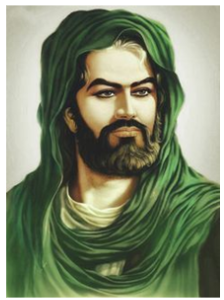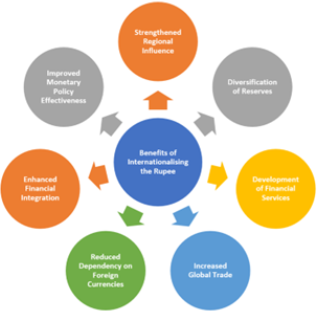November 2023 Current Affairs
Capital Punishment - Edukemy Current Affairs
In News: The parliamentary committee that examined the Bharatiya Nyaya Sanhita (BNS), has proposed a criminal statute to replace the IPC, but it has not made a recommendation to abolish the death penalty
Introduction to The Capital Punishment
- The death penalty, the most severe form of punishment globally, is entrenched in India's legal system, although there is a growing movement advocating for its abolition.
- Events, such as the Supreme Court's dismissal of a petition for the immediate execution of convicts in the Nirbhaya case, highlight the ongoing debate.
- The Indian Penal Code, along with other laws like the Unlawful Activities Prevention Act, allows for the death penalty in specific offenses.
- The Constitution empowers the President and Governors to grant clemency, and the capital punishment verdict must be confirmed by the High Court.
- India, while retaining the death penalty, does not employ it as frequently as some other countries, aligning with a 2007 UN resolution urging a moratorium on its administration.
Why capital punishment should be abolished?
- The death penalty lacks efficacy and purpose in India and much of the civilized world, with no evidence supporting its deterrent effect on crime.
- Studies suggest that for deterrence to be effective, severity must coexist with certainty and swiftness of punishment, conditions not met by capital punishment.
- The legal system's fallibility is evident, as the Supreme Court has admitted errors in 25% of death sentences imposed between 2000 and 2015.
- The death penalty disproportionately impacts the poor and marginalized, who may lack adequate legal representation.
- Moreover, its administration is acknowledged to be arbitrary and dependent on the personal beliefs of adjudicators, leading to inconsistent outcomes.
Why capital punishment should not be abolished?
- The constitutionality of the death penalty has been upheld not only in India but also in liberal democracies like the United States.
- Its retention is seen as a reflection of the individual geopolitical circumstances of each state rather than a characteristic of "uncivilized" polities defined by violence.
- While early reports suggested studying the impact on a new republic, recent recommendations from the Law Commission did not advocate absolute abolition.
- The exception for terror cases is justified by India's challenging geopolitical environment, where attempts to destabilize the nation are frequent.
- The death penalty, according to the Law Commission, is considered a crucial component of the national response, particularly in cases of violent terror.
- Defenders argue for retributive justice, asserting that certain acts deemed heinous justify the ultimate punishment as a means of protecting society and affirming the sanctity of life.
- Notable executions, like those of Ajmal Kasab and Yakub Memon, are viewed as expressions of India's commitment to upholding life.
Way Forward
- The capital punishment in India is not considered arbitrary as it stems from a judicial process, with courts exercising caution due to the irreversibility of the penalty.
- Executions are restricted to rarest of rare cases that shock society's conscience.
- Recent amendments, particularly after the 2012 Delhi gang rape, expanded the scope of the death penalty for specific crimes, sparking polarized debates.
- The "rarest of rare" threshold set by the Constitution Bench in 1980 emphasizes that death should only be imposed when no alternative option is viable.
- While the Law Commission called for the abolition of the death penalty for ordinary crimes in 2015, political will in India remains influenced by populism.
- The constitutionality of the death penalty continues to be challenged, and the Supreme Court may have to address whether the absence of political will can override the right to life.
- Additionally, recent Supreme Court rulings emphasize the rights of death row convicts, affirming their fundamental right to dignity and equality through reasonable access to family, friends, lawyers, and mental health professionals.
Source: TH
Unlocking Women's Political Power: Bridging the Gap Between Rhetoric and Action
In News: The sparse inclusion of women candidates in recent Assembly elections, despite a new law, reveals a lack of political commitment to women's empowerment.
The State of Women in Politics and Bureaucracy
- In Politics
- According to data from the Inter-Parliamentary Union (IPU), women constitute 14.44% of the 17th Lok Sabha in India.
- The Election Commission of India (ECI) reports that, as of October 2021, women make up 10.5% of all Members of Parliament.
- The representation of female MLAs in state assemblies’ averages around 9%. India's ranking in this context has declined in recent years, trailing behind countries like Pakistan, Bangladesh, and Nepal.
- In Bureaucracy
- Despite initiatives facilitating free applications for women candidates in various public service jobs, their participation remains low.
- According to Indian Administrative Services (IAS) data and the central government's 2011 employment census, women accounted for less than 11% of total employees, a figure that increased to 13% in 2020.
- In 2022, only 14% of IAS Secretaries were women.
- Across Indian states and union territories, there are only three women chief secretaries, and India has never had a woman cabinet secretary.
- Women have not held positions as Secretaries of Home, Finance, Defence, and Personnel.
Challenges Leading to the Underrepresentation of Women in Politics and Bureaucracy
- Patriarchal Mindset
- Preconceived notions about women's inferiority impact their perceived ability to lead and participate in these domains.
- Social Norms and Stereotypes
- Traditional gender roles and societal expectations discourage women from pursuing political careers
- Limited Access to Education
- Historical barriers to education for women impede their political participation.
- Limited Representation in Political Parties
- Underrepresentation of women in political parties hampers their progression and nomination for elections.
- Gender biases within parties contribute to the perception that women are less electable than men.
- Violence and Harassment
- Women in politics face various forms of violence and harassment, both physical and online, creating a hostile environment.
- Unequal Opportunities
- Inequalities in opportunities, such as lower salaries and limited access to resources and networks, hinder women's competitiveness against male counterparts.
- Structural Impediments
- Structural impediments, including distant postings, patriarchal conditioning, and the challenge of balancing family commitments, discourage women from pursuing civil services.
Enhancing Women's Representation in Politics
- Implementing seat reservations for women in legislative bodies, as seen in states like Bihar, Odisha, and West Bengal, where a percentage of seats are exclusively reserved for women in local bodies
- Political parties should actively ensure adequate representation of women in candidate selection for elections.
- Special efforts should be made to recruit and prioritize women candidates, particularly in winnable seats.
- Conducting education and training programs to empower women in politics, building their confidence, enhancing their skill sets, and providing insights into the intricacies of political involvement.
- Encouraging and supporting local women leaders through mentorship programs and other initiatives to foster their growth and participation in politics.
- Taking measures to address violence against women in politics, including awareness campaigns and creating safe environments to ensure the safety and security of women involved in political activities.
- Addressing social and cultural barriers such as patriarchy and gender norms through campaigns, educational programs, and initiatives like Beti Bachao Beti Padhao Scheme and Sukanya Samriddhi Yojana.
- Providing support for work-life balance, including flexible schedules, childcare facilities, and parental leave to assist women in managing their political responsibilities alongside family and personal commitments.
- Enhancing the visibility and recognition of women in politics, acknowledging their achievements to inspire other women to engage in politics and fostering a culture of gender equality in the political arena.
- Introducing innovative initiatives like the Kerala government's decision to grant menstrual leave for female students in state universities under the Department of Higher Education.
|
UPSC Previous Year Questions Mains (2019) Q.1 What are the continued challenges for Women in India against time and space? Mains (2021) Q.2 Discuss the desirability of greater representation to women in the higher judiciary to ensure diversity, equity and inclusiveness. |
Source: TH
Same-sex couples: A judge to the rescue
In News: Following the disappointing Supreme Court ruling, Judge Anand Venkatesh brings optimism for LGBTQIA+ couples.
Challenges Encountered by the LGBTIQ+ Community
- Heteronormativity
- Inequality and Violence
- Deprivation of Rights
- Social Isolation
- Family Conflict
- Racial Discrimination
Sushma vs Commissioner of Police
- This case advocates for the incorporation of rights and protections for the LGBTIQ+ community, addressing issues related to harassment, violence, and discrimination in areas such as employment, housing, and societal integration.
- The State government is mandated to implement these measures.
Supriyo Judgment
- No inherent right to marriage is recognized as a fundamental right.
- Discrepancies exist between majority and minority opinions regarding the recognition of civil unions.
- The minority viewpoint supports acknowledging a range of entitlements.
- However, the judgment falls short of providing explicit rights and precise directives.
- The majority opinion leaves the fate of same-sex couples to the discretion of the government and legislature.
- The Supreme Court has emphasized that statutory laws, including the Constitution and marriage laws, cannot be invoked in this matter.
Concerns with the Judgment
- Doctrine of Indirect Discrimination:
- The judgment raises issues with the doctrine of indirect discrimination, emphasizing that the discriminator cannot evade constitutional obligations by citing intent or object.
- Impact Assessment Requirement
- The court is urged to consider the impact of a law on a specific group, as emphasized in Nitisha v. Union of India, 2021, challenging the notion that the mere absence of a law is enough to claim discrimination.
- Failure to Address Discrimination Based on Sexual Orientation
- The State's decision to deny recognition to a specific category of marriages solely based on sexual orientation is not explicitly confronted by the Bench.
- Lack of Resolution on Institutional Limitations
- The judgment does not effectively address the issue of whether the court can strike down the constitutional validity of the Special Marriage Act (SMA) or introduce modifications due to its institutional constraints.
- Reluctance to Challenge Unconstitutional Laws
- The court's stance suggests that even if a law is blatantly unconstitutional, the difficulties in providing a remedy are deemed sufficient reason to retain the unconstitutional law.
Recommended Actions
- Avoiding Constitutional Scrutiny in Legislation
- Parliament can craft laws in a manner that necessitates the court to engage in intricate interpretation, potentially sidestepping direct constitutional scrutiny.
- Recognizing Equal Rights Beyond Policy
- Conceiving the issue of equal rights in marriage solely as a policy matter is problematic and should be expanded beyond this narrow perspective.
- Establishing a Registration Procedure
- Implementing a registration process for contracts related to same-sex unions would allow the State to endorse relationships within the community, providing societal recognition and protection.
- Institution of Civil Unions
- The State government has the authority to enact legislation introducing the institution of Civil Unions, thereby conferring a formal status on same-sex couples.
- This can encompass various aspects, including marriage, divorce, inheritance, succession, minors, and adoption.
- Utilizing Legislative Powers
- Given that laws pertaining to marriage, divorce, and related matters fall under the Concurrent List in the Seventh Schedule of the Constitution, states possess the authority to legislate on these subjects.
- This grants the State the power to enact comprehensive legislation addressing the needs of same-sex couples.
Source: TH
Adapting to Climate Change with Climate-Smart Agriculture.
In News: In the 21st century the ongoing climate change effects, such as heat waves, flash floods, and droughts, are adversely impacting lives and livelihoods.
Understanding Climate-Smart Agriculture
Definition
Climate-smart agriculture serves as a strategic approach guiding the shift towards environmentally friendly and climate-resilient practices within agri-food systems. Aligned with global targets like the SDGs and the Paris Agreement, it addresses three core objectives:
- Enhancing Productivity and Incomes
- Sustainably increasing agricultural productivity and incomes for a resilient farming community.
- Adapting to Climate Change
- Building resilience to climate change by implementing adaptive strategies.
- Reducing Greenhouse Gas Emissions
- Minimizing or eliminating greenhouse gas emissions through sustainable practices.
Examples of Climate-Smart Practices
- Cultivating Resilient Crop
- Growing crop varieties resistant to climate challenges, pests, and diseases.
- Conservation Agriculture
- Employing no-till and reduced-tillage methods for improved soil health and biodiversity.
- Agroforestry
- Integrating trees and shrubs to create diverse, productive, and environmentally beneficial agricultural systems.
- Precision Irrigation
- Utilizing technologies like drip irrigation and sensors to optimize water use efficiency.
- Variable Rate Fertilization
- Tailoring fertilizer application based on specific crop and field requirements using technology.
Benefits of Climate-Smart Agriculture
- Enhanced Agricultural Productivity
- Climate-smart agriculture (CSA) addresses the challenge of declining resources and rising demand, contributing significantly to climate adaptation, mitigation, and food security.
- Studies in India demonstrate that CSA techniques improve agricultural production, sustainability, and reliability while reducing greenhouse gas (GHG) emissions.
- GHG Emission Reduction
- Given the substantial GHG emissions from agriculture, CSA becomes crucial in achieving emission reduction goals and preserving biodiversity.
- CSA practices, such as agroforestry and carbon sequestration, align with global efforts like the Paris Agreement and contribute to India's international commitments.
- Support for Small Farmers
- In a country where the majority of farmers are small or marginal, CSA plays a vital role in enhancing their profitability.
- CSA adoption becomes essential at the intersection of climate vulnerability and agricultural significance, supporting the economic well-being of small and marginal farmers.
- Biodiversity Conservation
- CSA's ecosystem-based approach and diverse crop varieties foster coexistence between cropland and wild areas.
- This collaboration contributes to safeguarding native plant species, stabilizing pollinator populations, and mitigating habitat degradation effects.
- Reduced Climate Change Impact
- CSA promotes crop diversification, improves water efficiency, and integrates drought-resistant crop varieties, mitigating the disruptive effects of climate change.
- By enhancing resilience to climate-related risks and shocks, CSA prepares agriculture to face challenges like shorter seasons and erratic weather patterns.
Challenges Facing Climate-Smart Agriculture in India
- Limited Awareness and Knowledge
- Challenge of Awareness and Understanding in CSA Adoption.
- Farmers and extension workers may lack awareness of CSA benefits and effective implementation methods.
- Financial, Insurance, and Market Access Constraints
- Financial Constraints in CSA Adoption: Overcoming Barriers.
- Limited access to finance, insurance, and markets poses hurdles for farmers investing in CSA technologies.
- Inadequate Infrastructure and Institutional Support
- CSA Success Relies on Infrastructure and Institutions.
- Supportive infrastructure, including irrigation systems, storage facilities, and guidance from organizations, is vital for CSA success.
- High Costs and Perceived Risks
- Economic Barriers to CSA Adoption: Costs and Risks.
- Initial adoption costs and perceived risks associated with new technologies can be significant obstacles for farmers.
- Policy and Regulatory Obstacles
- Policy Hindrances in CSA Uptake: Addressing Barriers.
- Policies that do not incentivize CSA and regulatory barriers may impede the widespread adoption of climate-smart agricultural practices.
Measures for Enhancing Climate-Smart Agriculture Adoption
- Capacity Building and Awareness
- Comprehensive training, demonstrations, farmer-to-farmer exchanges, and mass media initiatives to enhance understanding of CSA principles and practices.
- Financial and Technical Support
- Providing financial aid and technical assistance to farmers, including subsidies, credit facilities, insurance coverage, market linkages, and digital platforms to encourage the adoption of CSA technologies.
- Policy and Institutional Strengthening
- Strengthening policies and institutions to promote CSA, incorporating CSA into national and state climate action plans, establishing a dedicated CSA fund, and creating a coordination committee for effective implementation.
|
UPSC Previous Year Questions Prelims (2018) Q. With reference to the circumstances in Indian agriculture, the concept of “Conservation Agriculture” assumes significance. Which of the following fall under the Conservation Agriculture?
Select the correct answer using the code given below: (a) 1, 3 and 4 (b) 2, 3, 4 and 5 (c) 2, 4 and 5 (d) 1, 2, 3 and 5 Ans: (c) Prelims (2018) Q2. With reference to the ‘Global Alliance for ClimateSmart Agriculture (GACSA)’, which of the following statements is/are correct?
Select the correct answer using the code given below: (a) 1 and 3 only (b) 2 only (c) 2 and 3 only (d) 1, 2 and 3 Ans: (b) Prelims (2021) Q3. In the context of India’s preparation for Climate-Smart Agriculture, consider the following statements:
Which of the statements given above are correct? (a) 1 and 2 only (b) 2 and 3 only (c) 1 and 3 only (d) 1, 2 and 3 Ans: (d) Mains (2014) Q1. Discuss the various economic and socio-cultural forces that are driving increasing feminization of agriculture in India. Mains (2021) Q2. What are the present challenges before crop diversification? How do emerging technologies provide an opportunity for crop diversification? |
Source: TH
Electrifying fleets as a solution to combat urban pollution.
In News: The air quality index (AQI) in numerous Indian cities has consistently reached the red zone on multiple occasions this year, underscoring the importance of improved pollution mitigation strategies.
Advantages of Electrifying fleets
- Environmental Advantages of Electric Vehicles
- Electric Vehicles (EVs) play a pivotal role in curbing climate change by minimizing greenhouse gas emissions.
- Unlike traditional fossil fuel vehicles, EVs generate zero tailpipe emissions, reducing air pollution and contributing to a healthier environment.
- They mitigate the release of harmful pollutants such as nitrogen oxides and particulate matter, resulting in improved public health.
- Energy Diversity and Security Enhancement
- EVs contribute to energy diversity by diminishing reliance on oil imports.
- With the flexibility to draw power from a variety of sources, including renewable energy like solar and wind, EVs offer a pathway to cleaner and more sustainable transportation.
- This diversification reduces vulnerability to oil price fluctuations and enhances energy security by reducing dependence on fossil fuel imports.
- Technological Advancements and Employment Opportunities
- The adoption of EVs stimulates advancements in battery technology, electric drivetrains, and charging infrastructure.
- Beyond benefiting the automotive sector, these technological strides have broader applications, such as energy storage for renewables and grid stability.
- The shift towards electric mobility fosters job creation and innovation, particularly in battery manufacturing, renewable energy, and charging infrastructure.
- Urban Decongestion through Electric Mobility
- Electric vehicles contribute to the decongestion of urban areas through the promotion of shared mobility and compact vehicle design.
- Shared mobility services reduce the overall number of vehicles on the road, minimizing the demand for parking spaces.
- Compact EV designs, suited for urban environments, offer a solution to congestion and emissions, providing a more efficient and sustainable urban transport option.
Challenges
- Economic Barrier: High Initial Investment in Electric Vehicles
- The initial purchase cost of electric vehicles (EVs) remains considerably higher compared to traditional vehicles, mainly due to the expensive battery technology utilized.
- This elevated upfront expense presents a financial challenge for many potential buyers, impeding broader adoption.
- Infrastructure Hurdle: Limited Charging Facilities
- Charging infrastructure in India is still in its infancy, primarily concentrated in major urban centers.
- This limited and uneven distribution poses challenges for EV owners, particularly those residing in apartments or lacking dedicated parking spaces.
- The inadequate charging network hampers the convenience of EV usage.
- Range Concerns: Overcoming Range Anxiety
- The fear of running out of battery charge, commonly known as range anxiety, remains a significant hurdle for EV adoption.
- Despite improvements in driving ranges, there persists a perception that EVs may not offer sufficient mileage for long-distance travel, a concern exacerbated in a country like India with vast distances.
- Battery degradation over time also contributes to this challenge.
Facilitating EV Adoption in India: A Strategic Roadmap
- Financial Incentives for Affordability
- Implement subsidies, tax incentives, and financing schemes for both consumers and manufacturers to mitigate the high initial costs associated with electric vehicles (EVs).
- Encourage financial institutions to offer favorable loan terms for EV purchases.
- Diverse EV Models and Collaboration
- Promote innovation and competition among Original Equipment Manufacturers (OEMs) and start-ups to increase the variety of available EV models.
- Foster collaborative efforts among stakeholders to advance research and development in the EV sector.
- Boosting Domestic Manufacturing
- Provide incentives and formulate supportive policies to stimulate domestic manufacturing of EVs and related components.
- Facilitate the creation of a robust supply chain for EV production within the country.
- Public Awareness Campaigns
- Launch comprehensive campaigns, portals, and platforms to educate the public about the benefits and incentives associated with EV adoption.
- Highlight the positive environmental impact, reduced operating costs, and long-term savings.
- Revamping Energy Infrastructure
- Invest in renewable energy sources to improve the sustainability of the electricity grid.
- Implement smart grid technologies and energy storage systems to enhance energy distribution and supply for EV charging.
|
UPSC Previous Year Questions Prelims (2016) Q. In the cities of our country, which among the following atmospheric gases are normally considered in calculating the value of Air Quality Index?
Select the correct answer using the code given below: (a) 1, 2 and 3 only Ans: (b) Prelims (2016) Q. With reference to the Agreement at the UNFCCC Meeting in Paris in 2015, which of the following statements is/are correct?
Select the correct answer using the code given below: (a) 1 and 3 only Ans: (b) Mains (2021) Q. Describe the major outcomes of the 26th session of the Conference of the Parties (COP) to the United Nations Framework Convention on Climate Change (UNFCCC). What are the commitments made by India in this conference? |
Source: TH
A $5 trillion economy, but who will benefit?
In News: Even as India is poised to become the world's third-largest economy by 2028, 800 million Indians will continue to receive complimentary food grains to combat hunger.
Unveiling Inequities: A Multifaceted Look at Socio-economic Disparities in India
- Gender Injustice
- India's Global Gender Gap ranking (2018) at 142 out of 149 countries.
- Women contend with a substantial gender wage gap, earning 34% less than men.
- Despite constituting 42% of the agricultural workforce, women own less than 2% of farm land.
- Caste Struggles
- Caste plays a pivotal role in determining access to education, income, and health resources.
- Upper caste households earn nearly 47% more than the national average.
- In 2012, the top 10% within upper castes owned 60% of the wealth in the group.
- Faith-Based Inequalities
- Religious identities wield significant influence on an individual's resource access.
- Prejudices stemming from religious identity contribute to economic exclusion.
- While certain minority groups enjoy a larger share of income, Muslim and Buddhist populations face reduced access to economic resources.
- Ethnic Divides
- Ethnic inequalities persist, particularly among tribal communities with unique cultural attributes.
- National Family Health Survey 2015-16 highlights wealth bracket variations among SC, OBC, and ST populations.
- Economic Disparities
- Oxfam's 2019 report underscores substantial wealth concentration, with India's top 10% holding 77.4% of the national wealth.
- The bottom 60% of the population possesses only 4.8% of the national wealth.
- Approximately 13.6 crore Indians in the poorest 10% have remained in debt for the past 15 years.
- India's Gini coefficient, indicating wealth inequality, stood at 0.83 in 2017, placing it among countries with high inequality.
Unraveling the Ripple Effects: Ramifications of Social Inequities in India
- Inequalities in India spawn social conflicts among groups, evident in caste clashes like the demands for reservations by groups such as Jaats, Marathas, and Patels.
- These conflicts highlight the clash of interests, with existing beneficiaries opposing new claims, leading to violent confrontations.
- Ethnic disparities contribute to movements seeking separate states or autonomy, even secession.
- The North East has witnessed ethnic movements, such as the Naga movement for greater Nagalim, underscoring the consequences of ethnic inequalities.
- Religious inequality fosters feelings of exclusion among religious minorities, hindering their mainstream participation.
- In India, this economic exclusion compromises national GDP growth, given the significant population of religious minorities.
- Existing socio-economic inequalities correlate with poor development indicators, including high rates of infant and maternal mortality, low per capita income, subpar education outcomes, and rapid population growth.
- Economic inequality negatively impacts public healthcare and education.
- The upper and middle classes, with access to private alternatives, often lack vested interests in the effectiveness of public healthcare and education systems, exacerbating the consequences of economic disparities.
Building Equality: Strategic Measures to Tackle Socio-Economic Disparities in India
- Constitutional Safeguards
- Enforce constitutional guarantees of equality outlined in fundamental rights, emphasizing Articles 14, 15, and 16.
- These articles collectively form a crucial framework ensuring the right to equality.
- Civil Society Empowerment
- Empower traditionally oppressed groups by amplifying their voices through civil society entities such as unions and associations.
- Encourage entrepreneurship among Scheduled Castes and Scheduled Tribes, expanding initiatives like Stand Up India to enhance accessibility through increased funding.
- Women's Empowerment
- Promote gender equality through affirmative action, reserving seats in legislatures, ensuring 50% reservation at local self-government levels, enforcing The Equal Remuneration Act, 1976 to bridge the wage gap, introducing gender-sensitive education curricula, raising awareness with programs like Beti Bachao Beti Padhao.
- Inclusion of Religious Minorities
- Address the needs of religious minority groups with a focus on representation in government jobs, provision of institutional credit, improved education access, protection of human rights through an empowered National Commission for Minorities, and reinforcing the rule of law.
- Progressive Taxation
- Generate additional public resources for essential services by implementing progressive taxes on the wealthy and enhancing corporate taxation, with a crucial emphasis on broadening the tax base through improved financial transaction monitoring.
- Economic Policy Reforms
- Ensure universal access to high-quality public services, including healthcare, education, and social security benefits. Implement employment guarantee schemes to significantly reduce inequality.
- Employment Generation
- Prioritize the growth of labor-intensive manufacturing sectors such as textiles, clothing, automobiles, and consumer goods.
- This strategy aims to absorb millions leaving farming, addressing the rural-urban migration challenge and benefiting the broader population.
Source: TH
Electrifying fleets as a solution to combat urban pollution.
In News: The air quality index (AQI) in numerous Indian cities has consistently reached the red zone on multiple occasions this year, underscoring the importance of improved pollution mitigation strategies.
Advantages of Electrifying fleets
- Environmental Advantages of Electric Vehicles
- Electric Vehicles (EVs) play a pivotal role in curbing climate change by minimizing greenhouse gas emissions.
- Unlike traditional fossil fuel vehicles, EVs generate zero tailpipe emissions, reducing air pollution and contributing to a healthier environment.
- They mitigate the release of harmful pollutants such as nitrogen oxides and particulate matter, resulting in improved public health.
- Energy Diversity and Security Enhancement
- EVs contribute to energy diversity by diminishing reliance on oil imports.
- With the flexibility to draw power from a variety of sources, including renewable energy like solar and wind, EVs offer a pathway to cleaner and more sustainable transportation.
- This diversification reduces vulnerability to oil price fluctuations and enhances energy security by reducing dependence on fossil fuel imports.
- Technological Advancements and Employment Opportunities
- The adoption of EVs stimulates advancements in battery technology, electric drivetrains, and charging infrastructure.
- Beyond benefiting the automotive sector, these technological strides have broader applications, such as energy storage for renewables and grid stability.
- The shift towards electric mobility fosters job creation and innovation, particularly in battery manufacturing, renewable energy, and charging infrastructure.
- Urban Decongestion through Electric Mobility
- Electric vehicles contribute to the decongestion of urban areas through the promotion of shared mobility and compact vehicle design.
- Shared mobility services reduce the overall number of vehicles on the road, minimizing the demand for parking spaces.
- Compact EV designs, suited for urban environments, offer a solution to congestion and emissions, providing a more efficient and sustainable urban transport option.
Challenges
- Economic Barrier: High Initial Investment in Electric Vehicles
- The initial purchase cost of electric vehicles (EVs) remains considerably higher compared to traditional vehicles, mainly due to the expensive battery technology utilized.
- This elevated upfront expense presents a financial challenge for many potential buyers, impeding broader adoption.
- Infrastructure Hurdle: Limited Charging Facilities
- Charging infrastructure in India is still in its infancy, primarily concentrated in major urban centers.
- This limited and uneven distribution poses challenges for EV owners, particularly those residing in apartments or lacking dedicated parking spaces.
- The inadequate charging network hampers the convenience of EV usage.
- Range Concerns: Overcoming Range Anxiety
- The fear of running out of battery charge, commonly known as range anxiety, remains a significant hurdle for EV adoption.
- Despite improvements in driving ranges, there persists a perception that EVs may not offer sufficient mileage for long-distance travel, a concern exacerbated in a country like India with vast distances.
- Battery degradation over time also contributes to this challenge.
Facilitating EV Adoption in India: A Strategic Roadmap
- Financial Incentives for Affordability
- Implement subsidies, tax incentives, and financing schemes for both consumers and manufacturers to mitigate the high initial costs associated with electric vehicles (EVs).
- Encourage financial institutions to offer favorable loan terms for EV purchases.
- Diverse EV Models and Collaboration
- Promote innovation and competition among Original Equipment Manufacturers (OEMs) and start-ups to increase the variety of available EV models.
- Foster collaborative efforts among stakeholders to advance research and development in the EV sector.
- Boosting Domestic Manufacturing
- Provide incentives and formulate supportive policies to stimulate domestic manufacturing of EVs and related components.
- Facilitate the creation of a robust supply chain for EV production within the country.
- Public Awareness Campaigns
- Launch comprehensive campaigns, portals, and platforms to educate the public about the benefits and incentives associated with EV adoption.
- Highlight the positive environmental impact, reduced operating costs, and long-term savings.
- Revamping Energy Infrastructure
- Invest in renewable energy sources to improve the sustainability of the electricity grid.
- Implement smart grid technologies and energy storage systems to enhance energy distribution and supply for EV charging.
|
UPSC Previous Year Questions Prelims (2016) Q. In the cities of our country, which among the following atmospheric gases are normally considered in calculating the value of Air Quality Index?
Select the correct answer using the code given below: (a) 1, 2 and 3 only Ans: (b) Prelims (2016) Q. With reference to the Agreement at the UNFCCC Meeting in Paris in 2015, which of the following statements is/are correct?
Select the correct answer using the code given below: (a) 1 and 3 only Ans: (b) Mains (2021) Q. Describe the major outcomes of the 26th session of the Conference of the Parties (COP) to the United Nations Framework Convention on Climate Change (UNFCCC). What are the commitments made by India in this conference? |
Source: TH
A $5 trillion economy, but who will benefit?
In News: Even as India is poised to become the world's third-largest economy by 2028, 800 million Indians will continue to receive complimentary food grains to combat hunger.
Unveiling Inequities: A Multifaceted Look at Socio-economic Disparities in India
- Gender Injustice
- India's Global Gender Gap ranking (2018) at 142 out of 149 countries.
- Women contend with a substantial gender wage gap, earning 34% less than men.
- Despite constituting 42% of the agricultural workforce, women own less than 2% of farm land.
- Caste Struggles
- Caste plays a pivotal role in determining access to education, income, and health resources.
- Upper caste households earn nearly 47% more than the national average.
- In 2012, the top 10% within upper castes owned 60% of the wealth in the group.
- Faith-Based Inequalities
- Religious identities wield significant influence on an individual's resource access.
- Prejudices stemming from religious identity contribute to economic exclusion.
- While certain minority groups enjoy a larger share of income, Muslim and Buddhist populations face reduced access to economic resources.
- Ethnic Divides
- Ethnic inequalities persist, particularly among tribal communities with unique cultural attributes.
- National Family Health Survey 2015-16 highlights wealth bracket variations among SC, OBC, and ST populations.
- Economic Disparities
- Oxfam's 2019 report underscores substantial wealth concentration, with India's top 10% holding 77.4% of the national wealth.
- The bottom 60% of the population possesses only 4.8% of the national wealth.
- Approximately 13.6 crore Indians in the poorest 10% have remained in debt for the past 15 years.
- India's Gini coefficient, indicating wealth inequality, stood at 0.83 in 2017, placing it among countries with high inequality.
Unraveling the Ripple Effects: Ramifications of Social Inequities in India
- Inequalities in India spawn social conflicts among groups, evident in caste clashes like the demands for reservations by groups such as Jaats, Marathas, and Patels.
- These conflicts highlight the clash of interests, with existing beneficiaries opposing new claims, leading to violent confrontations.
- Ethnic disparities contribute to movements seeking separate states or autonomy, even secession.
- The North East has witnessed ethnic movements, such as the Naga movement for greater Nagalim, underscoring the consequences of ethnic inequalities.
- Religious inequality fosters feelings of exclusion among religious minorities, hindering their mainstream participation.
- In India, this economic exclusion compromises national GDP growth, given the significant population of religious minorities.
- Existing socio-economic inequalities correlate with poor development indicators, including high rates of infant and maternal mortality, low per capita income, subpar education outcomes, and rapid population growth.
- Economic inequality negatively impacts public healthcare and education.
- The upper and middle classes, with access to private alternatives, often lack vested interests in the effectiveness of public healthcare and education systems, exacerbating the consequences of economic disparities.
Building Equality: Strategic Measures to Tackle Socio-Economic Disparities in India
- Constitutional Safeguards
- Enforce constitutional guarantees of equality outlined in fundamental rights, emphasizing Articles 14, 15, and 16.
- These articles collectively form a crucial framework ensuring the right to equality.
- Civil Society Empowerment
- Empower traditionally oppressed groups by amplifying their voices through civil society entities such as unions and associations.
- Encourage entrepreneurship among Scheduled Castes and Scheduled Tribes, expanding initiatives like Stand Up India to enhance accessibility through increased funding.
- Women's Empowerment
- Promote gender equality through affirmative action, reserving seats in legislatures, ensuring 50% reservation at local self-government levels, enforcing The Equal Remuneration Act, 1976 to bridge the wage gap, introducing gender-sensitive education curricula, raising awareness with programs like Beti Bachao Beti Padhao.
- Inclusion of Religious Minorities
- Address the needs of religious minority groups with a focus on representation in government jobs, provision of institutional credit, improved education access, protection of human rights through an empowered National Commission for Minorities, and reinforcing the rule of law.
- Progressive Taxation
- Generate additional public resources for essential services by implementing progressive taxes on the wealthy and enhancing corporate taxation, with a crucial emphasis on broadening the tax base through improved financial transaction monitoring.
- Economic Policy Reforms
- Ensure universal access to high-quality public services, including healthcare, education, and social security benefits. Implement employment guarantee schemes to significantly reduce inequality.
- Employment Generation
- Prioritize the growth of labor-intensive manufacturing sectors such as textiles, clothing, automobiles, and consumer goods.
- This strategy aims to absorb millions leaving farming, addressing the rural-urban migration challenge and benefiting the broader population.
Source: TH
Governor’s Role
In News: Concerns about the behaviour of Governors have been raised in the ongoing proceedings before the Supreme Court.
The governor's authority concerning the passage of bills
The powers of the governor regarding the passage of bills are outlined in Article 200 and Article 201 of the Constitution. These articles delineate the following options available to the governor when presented with a bill from the state legislature:
- Assent-The governor may approve the bill, leading it to become law.
- Withhold Assent-The governor has the authority to reject the bill by refusing to give assent.
- Return with Message-If the bill is not a money bill, the governor can send it back to the state legislature with a message, requesting a reconsideration of the entire bill or specific provisions.
- If the bill is passed again by the state legislature, with or without amendments, the governor is obligated to give assent.
- Reservation for President's Consideration-The governor can reserve the bill for the consideration of the president. The president may choose to give assent, withhold assent, or instruct the governor to return the bill to the state legislature for further deliberation.
- Mandatory reservation occurs if the bill jeopardizes the position of the state high court.
- Discretionary reservation is applicable if the bill contradicts the Constitution, the Directive Principles of State Policy, the broader national interest, or if it involves matters of significant national importance.
- This also includes bills related to the compulsory acquisition of property under Article 31A of the Constitution.
Challenges in the Governor's Office: Navigating Issues of Appointment, Role, and Accountability
- Appointment Dilemmas
- Original Text: The governor is appointed by the president on the advice of the central government, raising concerns about political neutrality.
- Rephrased: The appointment process of governors, carried out by the president on the central government's advice, gives rise to questions regarding the political impartiality of the governor.
- Role and Powers Struggles
- Original Text: The governor's constitutional roles and powers, such as giving assent to bills and appointing ministers, may lead to conflicts with elected state governments.
- Rephrased: The constitutional roles and powers of the governor, including approving bills and appointing ministers, often result in conflicts with elected state governments.
- Accountability and Immunity Challenges
- Original Text: Governors, acting as Union government agents, can be removed at the pleasure of the Union government, enjoying immunity from legal repercussions during their term.
- Rephrased: Despite being considered the President's counterparts in state governance, governors, acting as agents of the Union government, face removal at the Union government's discretion and enjoy immunity from legal consequences during their tenure.
- Political Dimensions in Appointments
- Original Text: Instances of governors being appointed from the ruling party or facing transfers for political reasons undermine the dignity and stability of the office.
- Rephrased: The appointment of governors from the ruling party or their transfers for political motives erodes the dignity and stability of the governor's office.
- Challenges in Exercising Discretion
- Original Text: Governors' discretionary powers, exemplified by actions like delaying assent to bills or interfering in state universities, face criticism for being arbitrary or unconstitutional.
- Rephrased: The exercise of discretionary powers by governors, seen in actions like delaying bill assent or intervening in state universities, is often censured for its perceived arbitrariness or unconstitutionality.
Reforming the Role and Appointment of Governors in India: Constitutional Recommendations
- Judicial Oversight
- The Supreme Court can monitor governors' conduct to ensure adherence to the Constitution and the law, preventing arbitrary or partisan actions.
- Revamp Appointment and Removal Process
- Amend the Constitution to introduce a more transparent and consultative mechanism for governor appointments, involving a collegium or parliamentary committee.
- Make removal more challenging, requiring a resolution of the state legislature or a judicial inquiry.
- Enhance Governor's Status
- Grant the governor a status akin to the President, ensuring accountability to the state legislature through elections and impeachment.
- Elected Representative Status
- Make the governor an elected representative of the state rather than a Union government nominee, increasing accountability and legitimacy.
- Impeachment Provision
- Enable impeachment of governors by the state legislature on grounds of constitutional violation or misconduct, introducing a check on power and deterring misuse.
- Constitutional Reforms Suggested by Committees and Supreme Court:
- Sarkaria Commission (1988)
- Advocate presidential appointment after consulting the Chief Minister.
- Emphasize the governor's role as a bridge between the centre and the state, discouraging interference in the democratic process.
- Venkatachaliah Commission (2002)
- Propose a committee comprising the prime minister, home minister, Lok Sabha speaker, and state chief minister for governor appointments.
- Stress the importance of governors completing their five-year terms unless removed for specific reasons, with consultation with the Chief Minister.
- Punchhi Commission (2010)
- Recommend removing the phrase "during the pleasure of the President" for governor removal.
- Suggest that removal should require a resolution from the state legislature, ensuring stability and autonomy for states.
- BP Singhal vs Union of India (2010)
- Affirm the President's authority to remove a governor without assigning reasons.
- Emphasize that removal should not be arbitrary, capricious, or based on unreasonable grounds.
- Sarkaria Commission (1988)
|
UPSC Previous Year Questions Prelims (2018) Q. Consider the following statements:
Which of the statements given above is/are correct? (a) 1 only Ans: (c) Prelims (2014) Q. Which of the following are the discretionary powers given to the Governor of a State?
Select the correct answer using the code given below: (a) 1 and 2 only Ans: (b) Prelims (2013) Q. Which one of the following statements is correct? (a) In India, the same person cannot be appointed as Governor for two or more States at the same time (b) The Judges of the High Court of the States in India are appointed by the Governor of the State just as the Judges of the Supreme Court are appointed by the President (c) No procedure has been laid down in the Constitution of India for the removal of a Governor from his/her post (d) In the case of a Union Territory having a legislative setup, the Chief Minister is appointed by the Lt. Governor on the basis of majority support Ans: (c) |
Source: TH
Electoral Bonds - Edukemy Current Affairs
Context: As the constitutionality of electoral bonds faces increasing challenges, it is imperative for citizens to advocate for a fairer electoral landscape in the upcoming elections.
What are Electoral Bonds?
- The electoral bonds system, introduced in 2017 through a Finance bill and implemented in 2018, provides a mechanism for individuals and entities to contribute to registered political parties while maintaining donor anonymity.
- Key features include the issuance of bonds in denominations ranging from Rs 1,000 to Rs 1 crore by the State Bank of India (SBI), being payable to the bearer on demand and interest-free.
- These bonds can be purchased by Indian citizens or entities established in India, individually or jointly, and are valid for 15 calendar days from the date of issue.
- SBI is the sole authorized issuer of electoral bonds, distributed through designated branches.
- Eligibility for political parties to receive these bonds is contingent on being registered under Section 29A of the Representation of the People Act, 1951, and securing not less than 1% of the votes polled in the last general election.
- Electoral bonds can be acquired digitally or through cheques, with encashment permitted only through an authorized bank account of the political party.
- To ensure transparency and accountability, parties must disclose their bank account details with the Election Commission of India (ECI), and the entire donation process is conducted through banking channels.
- Political parties are also obligated to explain the utilization of the funds received.
- The system's benefits include heightened transparency in political party funding, accountability in disclosing donation utilization, discouragement of cash transactions, and the preservation of donor anonymity.
Issues with electoral Bonds
- The electoral bonds scheme, aimed at bringing transparency to election funding, has faced significant criticism for contradicting its basic idea.
- Critics argue that the anonymity provided by electoral bonds only shields donors from the broader public and opposition parties, leaving room for potential extortion and unfair advantages for the ruling party.
- The bonds, sold through a government-owned bank (SBI), raise concerns about the government's ability to identify donors, potentially leading to extortion or victimization of contributors.
- Additionally, the exemption of political parties from disclosing donations under the scheme compromises the voters' right to know, a fundamental aspect of a representative democracy.
- The Electoral Bonds Scheme has been accused of favoritism towards wealthy corporates, as it enables unlimited corporate donations with 100% tax exemption.
- This, coupled with the lack of transparency, opens the door to crony capitalism, allowing well-resourced corporations to influence elections without limits.
- The scheme's impact on free and fair elections is questioned, as the government can access donor details, potentially disrupting the democratic process.
- The removal of pre-existing limits on political donations further exacerbates concerns about crony capitalism, fostering close relationships between business leaders and government officials.
Way Forward
- Effective regulation of political financing, coupled with bold reforms, is essential to disrupt the harmful cycle of corruption and the deterioration of the quality of democratic governance.
- It is imperative to address the loopholes in existing laws to enhance accountability and transparency throughout the governance machinery.
- Citizens can play a significant role in driving substantial changes by advocating for awareness campaigns.
- By rejecting candidates and political parties that engage in overspending or bribery, voters can contribute to elevating the standards of democracy.
Source: TH
‘70-hour work week’ idea into perspective
Context: Infosys co-founder Narayana Murthy has recommended that Indian youth should adopt a 70-hour workweek to enhance the country's productivity. The proposal of a 70-hour workweek, equivalent to nearly 12 hours of daily work for six days, has elicited mixed reactions, receiving both support and criticism.
Current Scenario
- The 2019 Time Use Survey reveals that, on average, young Indians aged 15-29 work for approximately 7.2 hours a day in rural areas and 8.5 hours a day in urban areas.
- In urban Uttarakhand, the average working hours are notably high at 9.6 hours per day.
- However, these figures still fall significantly short of the 70-hour workweek suggested by Narayana Murthy.
Pros of long working hours
- India has a significant advantage with a young working-age population, making it crucial to harness their potential by encouraging long working hours to contribute to the nation's development.
- To achieve ambitious goals in a short time, India needs a transformation in work culture towards greater determination, discipline, and diligence.
- Historical examples from Germany and Japan demonstrate the benefits of long working hours in driving economic growth, which can be a model for India's progress.
- India's low work productivity needs improvement to compete on a global scale and make significant economic progress.
- Long working hours can also be allocated to personal skill development, ensuring that the additional time is dedicated to mastering expertise in one's chosen field.
Cons of long working hours
- Research consistently indicates a significant drop in productivity after 50 hours of work per week, which worsens beyond 55 hours. A lack of a full day off each week can further harm hourly output.
- Long work hours can lead to burnout, reduced job satisfaction, and disrupt the balance between work and personal life. Indians already spend less time on sports and leisure compared to Germany and Japan.
- Extended working hours can result in various health issues, including sleep disturbances, increased risk of cardiovascular diseases, obesity, and mental health problems like elevated stress levels, anxiety, and depression.
- Long working hours can be particularly challenging for working mothers, making it difficult to manage childcare responsibilities and potentially hindering their career progression.
How to achieve the Golden Mean of work-life balance?
- Utilize digital technologies and artificial intelligence to streamline processes and invest in technical education for the workforce.
- Productivity relies on the right tools and resources, not just time spent at work.
- Place youth in challenging roles that offer promising futures, fostering a culture of transparency and meritocracy.
- Allocate time for relaxation, exercise, hobbies, and spending time with loved ones, aiming for sufficient quality sleep each night.
Hard work forms the cornerstone of success, but it's more than just the hours clocked; it's the commitment and passion that truly count. The aim is to create a sense of satisfaction in one's work, enabling a seamless blend of professional and personal life. When young individuals are driven by purpose and enthusiasm, achieving a harmonious work-life balance becomes an organic result.
Source: TH
Net Neutrality - Edukemy Current Affairs
In News: In response to the government's request, the Telecom Regulatory Authority of India (TRAI) has launched a consultation process to discuss the regulation of Over-The-Top (OTT) services.
About Net Neutrality
- 'Net Neutrality' is the principle advocating for the impartial treatment of internet traffic by intermediate networks, without discrimination based on any criteria.
- This means that the network should remain neutral to all information transmitted through it.
- In the context of net neutrality, all communication passing through a network should be treated equally, regardless of its content, application, service, device, sender, or recipient address.
- This ensures that everyone, regardless of their financial resources or the size and influence of the websites they use, has equal access to information and services on the internet.
- The term "net neutrality" gained prominence through Tim Wu, a professor at Columbia Law School, who popularized it in his 2003 paper titled "Network Neutrality, Broadband Discrimination."
- Stakeholders affected by net neutrality in the internet domain encompass:
- Consumers of any internet service
- Telecom Service Providers (TSPs) or Internet Service Providers (ISPs)
- Over-the-top (OTT) service providers, encompassing those offering internet access services such as websites and applications
- The government, which may oversee and establish the relationships between these entities
- Additionally, TRAI functions as an autonomous regulator in the telecom sector, primarily overseeing Telecom Service Providers (TSPs) and their licensing conditions, among other responsibilities.
Importance of Net Neutrality
- Ensures an Open Internet: Net neutrality guarantees unrestricted access to information, ideas, and services, promoting a free flow of content.
- Prevents Discrimination by ISPs: In the absence of net neutrality, individual Internet Service Providers (ISPs) could prioritize certain websites with higher connection speeds while throttling access to others. In extreme cases, an ISP might even block access to specific content.
- Empowers Consumer Choice: Net neutrality grants consumers the freedom to choose the content, applications, and services they wish to access without limitations. It liberates them from being confined to a predetermined set of offerings dictated by ISPs.
- Preserves Freedom of Expression: By preventing interference, net neutrality safeguards the freedom of expression, allowing individuals to organize, communicate, and mobilize supporters unhindered. It stands as a crucial tool for democratic engagement.
- Encourages Innovation: An open internet creates an environment conducive to innovation and competition. Startups, small businesses, and entrepreneurs enjoy equal opportunities to launch new services and connect with users, eliminating the necessity to negotiate deals with ISPs.
- Curbs Anti-Competitive Practices: Net neutrality rules act as a safeguard against potential anti-competitive behaviour by ISPs, such as favouring their own content or services or those of their partners. These rules prevent discriminatory practices, maintaining a level playing field for fair competition.
Key concerns regarding Net Neutrality in India
- Telecom Companies' Perspective
- Over the past decade, telecom firms have experienced decreasing revenue, attributed mainly to the rise of free competing Over-The-Top (OTT) services.
- Telecom Service Providers (TSPs) emphasize substantial investments in network infrastructure, seeking incentives like differential pricing to sustain and expand internet penetration.
- Telecom companies argue that OTT services face an uneven taxation and licensing fee landscape, creating an imbalanced competitive environment.
- OTT Platforms' Perspective
- OTT providers stress that telecom companies are conduits for internet access, and consumers already pay for this access through data plans.
- OTT platforms advocate for net neutrality to prevent discrimination by TSPs, ensuring equal access, fostering innovation, and supporting a democratic exchange of ideas.
- OTT platforms cover CDN expenses, competing based on content variety, quality, streaming, navigation ease, and device availability.
- Telecom companies can adjust prices to cover costs, capitalizing on demand created by OTT content and infrastructure investments.
- Concerns for Consumers
- Net neutrality supporters argue against imposing extra costs on OTT platforms, expressing concerns that such expenses may be transferred to subscribers, leading to higher fees or reduced service quality.
- Critics of net neutrality assert the importance of maintaining open competition in internet services to safeguard consumers' access and choice.
Way Forward
- Regulation Clarity
- TRAI should provide clear guidelines on net neutrality, preventing discrimination while allowing reasonable network management.
- Multi-Stakeholder Approach
- Seek a balanced approach considering the interests of both telecom companies and OTT service providers.
- Foster fair competition, innovation, and enable telecom companies to recover investments.
- Transparency
- Encourage transparency in ISPs' network management and collaboration with OTT providers.
- Continual Assessment
- Regularly evaluate net neutrality regulations, adapting to the evolving nature of the internet.
- Public Awareness
- Increase public awareness about net neutrality principles and their impact on consumers
Source: TH
Caution in Proposed OTT Legislation: Protecting Content
In News: A comprehensive law covering both traditional and digital broadcasters carries significant implications for the Indian internet landscape. It warrants careful scrutiny.
About Broadcasting Services (Regulation) Bill, 2023
- This legislation proposes a unified framework for regulating broadcasting services in the country, aiming to replace the current Cable Television Networks (Regulation) Act, 1995, and other existing Policy Guidelines governing the broadcasting sector.
- It simplifies regulatory procedures, expands its scope to encompass Over-the-Top (OTT) content and digital news, and incorporates modern definitions and provisions for emerging technologies.
- The bill is organized into 6 chapters, 48 sections, and 3 schedules.
Key Highlights of The Broadcasting Services (Regulation) Bill, 2023
- This legislation fulfils a longstanding requirement to consolidate and modernize regulatory provisions for various broadcasting services within a unified legislative framework.
- The bill aims to enhance regulatory efficiency by extending its scope to cover OTT content and digital news, which are presently regulated under the Information Technology Act, 2000.
- To adapt to evolving technologies, the bill introduces comprehensive definitions for contemporary broadcasting terms and includes provisions for emerging broadcasting technologies.
- The bill establishes Content Evaluation Committees and a Broadcast Advisory Council for self-regulation, outlines different program and advertisement codes for various broadcasting network operators, incorporates accessibility measures for individuals with disabilities, and outlines statutory penalties.
- The Broadcast Advisory Council is envisioned to have a chairperson with a minimum of 25 years of experience in media, entertainment, broadcasting, or related fields.
- It permits a nuanced approach to program and advertisement codes across different services, necessitates self-classification by broadcasters, and mandates robust access control measures for restricted content.
- The bill ties monetary penalties and fines to the financial capacity of entities, considering their investment and turnover for fairness and equity.
- Addressing the needs of individuals with disabilities, the bill introduces enabling provisions for comprehensive accessibility guidelines.
- Additionally, it includes provisions for infrastructure sharing among broadcasting network operators and the carriage of platform services.
- The Right of Way section is streamlined to handle relocations and alterations more efficiently, and a structured dispute resolution mechanism is established.
Why the bill is required?
- This legislation aligns with the Prime Minister's vision of promoting ease of doing business and enhancing the quality of life.
- Recognizing the increasing digitization of the broadcasting sector, particularly in cable TV, there is a pressing demand to rationalize and modernize the regulatory framework.
Conclusion
This Bill heralds a new era marked by transparency, self-regulation, and the establishment of future-ready broadcasting services in the country. By modernizing the regulatory framework of our broadcasting sector, it supersedes antiquated acts, rules, and guidelines, presenting a unified and forward-looking approach.
Source: IE
Overhauling the criminal justice system
In News: Three Bills have been introduced by the government to replace the foundational laws that underpin the criminal justice system.
About criminal justice system
- The criminal justice system comprises laws, procedures, and institutions designed to prevent, detect, prosecute, and penalize crimes, while safeguarding the rights and safety of individuals.
- This includes entities such as police forces, judicial institutions, legislative bodies, and supportive organizations like forensic and investigation agencies.
Proposed Changes in Legislation
- Bhartiya Nyaya Sanhita Bill, 2023
- Defines terrorism and related offenses.
- Repeals the offense of sedition.
- Prescribes capital punishment for mob lynching.
- Proposes 10 years imprisonment for deceptive sexual intercourse.
- Introduces community service as a punishment.
- Sets a maximum limit of 180 days for filing charge sheets.
- Bhartiya Nagarik Suraksha Sanhita Bill, 2023
- Promotes the use of technology in legal proceedings.
- Mandates video-recording of statements in sexual violence cases.
- Requires police to inform about complaint status in 90 days.
- Restructures Section 41A of CrPC for arrest approvals.
- Involves victims in case withdrawals.
- Allows trials in absentia for absconding criminals.
- Empowers magistrates with electronic record cognizance.
- Sets timelines for filing mercy petitions in death sentences.
- Bhartiya Sakshya Bill, 2023
- Defines electronic evidence and outlines admissibility criteria.
- Specifies provisions for DNA evidence admissibility.
- Recognizes expert opinions as valid evidence.
- Establishes the presumption of innocence as a fundamental principle in the criminal justice system.
Challenges in India’s current criminal justice system
- Pendency of Cases
- Over 4.7 crore cases pending, causing delays and eroding trust.
- Violation of the right to a speedy trial.
- Lack of Resources and Infrastructure
- Inadequate funding, personnel, and facilities.
- Shortage of judges, prosecutors, police, and legal aid lawyers.
- Poor Quality of Investigation and Prosecution
- Ineffective, biased, and non-professional investigations.
- Influence from political interference, corruption, and accountability issues.
- Human Rights Violations
- Accusations of human rights abuses, including torture, extrajudicial killings, false arrests, and unfair trials.
- Outdated Laws and Procedures
- Legal framework from 1860 not addressing modern crimes like cybercrime and terrorism.
- Public Perception
- Unfavourable police-public relations due to perceptions of corruption, inefficiency, and unresponsiveness.
Utility of current reforms
- Removal of Section 124A to address misuse against dissenters and government critics.
- Inclusion of terrorism, corruption, mob lynching, and organized crime.
- Extension of victim and offender categories to include men, women, and transgenders.
- Enhanced use of electronic evidence and forensics throughout the legal process.
- Ability to file police complaints at any station, irrespective of the crime location.
- Ensuring effective protection of citizens' constitutional rights, including the right to life, liberty, dignity, privacy, and a fair trial.
Loopholes in current reforms
- The proposed bills, developed by the Criminal Law Reforms Committee in 2020, face criticism for lacking consultation and transparency, potentially violating human rights, and exhibiting inconsistency.
- The absence of representation from key stakeholders and the lack of public disclosure for wider feedback raise concerns.
- Specific provisions, such as the introduction of vague terms and broad offenses, are highlighted for their potential impact on human rights, including free speech suppression.
- The bills are also criticized for inconsistencies between themselves and existing laws, raising questions about coherence and clarity in the proposed legal framework.
Way Forward
- Broad Consultation: Engage all stakeholders, including the public, for diverse perspectives before implementing reforms.
- Human Rights Protection: Clearly define and narrow vague terms, explicitly incorporating human rights principles to prevent potential misuse.
- Legal Framework Consistency: Ensure coherence across proposed bills and existing laws for a comprehensive legal structure.
- Technology Integration: Implement technology for evidence collection, online proceedings, and video-recorded statements for faster trials and transparency.
- Capacity Building: Invest in training, recruitment, and infrastructure for law enforcement, judiciary, and legal aid services to enhance efficiency.
- Restorative Justice: Adopt restorative justice principles to address crime root causes, reduce recidivism, and provide closure to victims.
- Public Awareness: Conduct awareness campaigns to educate the public about their rights and responsibilities within the criminal justice system for improved police-public relations.
|
UPSC Previous Year Questions Prelims (2008) Q. For which one of the following reforms was a Commission set up under the Chairmanship of Veerappa Moily by the Government of India? (a) Police Reforms Ans: (d) Mains (2014) Q. We are witnessing increasing instances of sexual violence against women in the country. Despite existing legal provisions against it, the number of such incidences is on the rise. Suggest some innovative measures to tackle this menace. Mains (2015) Q. Mob violence is emerging as a serious law and order problem in India. By giving suitable examples, analyse the causes and consequences of such violence. |
Source: TH
Menstrual Hygiene Policy - Edukemy Current Affairs
In News: The Supreme Court of India has granted the Central government a four-week deadline to formulate an effective menstrual hygiene policy, emphasizing a particular emphasis on the distribution of sanitary napkins.
Rationale for Menstrual Hygiene Policy
- Inadequate menstrual hygiene practices can contribute to various health issues, such as infections and discomfort.
- As per the 5th National Family Health Survey (2019-2021), 78% of women aged 15-24 years use a hygienic method of protection during menstruation, with variations in usage across different demographics.
- The survey reveals that while 73% of rural women utilize hygienic menstrual protection, a higher percentage of 90% is observed among urban women.
- Nevertheless, certain states still report below-average access to hygienic methods of protection, emphasizing the need for targeted policies.
- Access to adequate menstrual hygiene products and facilities is not just a health concern but a matter of dignity and fundamental human rights.
- A well-structured menstrual hygiene policy can ensure that individuals manage menstruation with dignity, free from shame or discomfort.
- Menstruation often carries social stigma and discrimination, perpetuating gender inequality.
- Implementing a menstrual hygiene policy becomes instrumental in challenging these societal norms, fostering gender equality, and addressing menstrual-related issues comprehensively.
- A dedicated policy can actively work towards promoting the widespread availability and affordability of menstrual hygiene products, ensuring that no individual is hindered by financial constraints from managing their menstrual health.
- Establishing a supportive work environment through the policy, encompassing initiatives like flexible working hours, easy access to sanitary products, and provisions for menstrual leave, can contribute to reduced absenteeism, heightened productivity, and increased work participation rates.
- A menstrual hygiene policy can facilitate access to essential products and support, removing obstacles that might otherwise impede girls from attending classes and pursuing education.
What all a comprehensive Menstrual Hygiene Policy should address?
- Access to Menstrual Hygiene Products
- Ensure widespread availability and affordability of menstrual hygiene products, including sanitary napkins, tampons, and menstrual cups.
- Education and Awareness
- Implement educational programs to raise awareness about menstrual health, hygiene practices, and debunk myths surrounding menstruation.
- Healthcare Services
- Provide accessible healthcare services to address menstrual health concerns and complications, including infections and discomfort.
- Social Support
- Foster a supportive societal environment that eliminates stigma and discrimination related to menstruation, promoting dignity and well-being.
- Hygienic Infrastructure
- Establish hygienic infrastructure in public spaces, including schools, workplaces, and public restrooms, to facilitate proper menstrual hygiene management.
- Environmental Sustainability
- Promote eco-friendly menstrual products and waste management practices to address environmental concerns associated with disposable sanitary products.
- Employment Policies
- Introduce workplace policies that support menstrual well-being, such as flexible working hours, access to sanitary products, and provisions for menstrual leave.
- Inclusivity in Education
- Ensure that educational institutions are equipped to support girls throughout their menstrual cycle, providing necessary facilities and minimizing disruptions to attendance.
- Research and Data Collection
- Conduct research and gather data on menstrual health to inform evidence-based policies and interventions.
- Period Poverty Alleviation
- Implement measures to alleviate period poverty by addressing financial barriers to accessing menstrual hygiene products.
Conclusion
The formulation of an inclusive and comprehensive menstrual hygiene policy is imperative to address the diverse needs of individuals across the entire lifecycle of menstruation. This policy should not only focus on ensuring access to menstrual hygiene products but should also encompass education, healthcare services, social support, and environmental sustainability.
Source: TH
Deepfakes
Context: This article delves into the implications of the recent deepfake video featuring actor Rashmika Mandanna, emphasizing the necessity of adopting a comprehensive regulatory framework for such technologies.
About Deepfakes
- Definition: A term denoting digitally manipulated synthetic media replacing one person's likeness with another, utilizing advanced AI techniques.
Applications of Deepfakes:
- Film Dubbing
- Utilizing deepfake technology for realistic lip-syncing, catering to actors speaking different languages, enhancing accessibility and immersion for a global audience.
- Education
- Harnessing deepfake technology to facilitate engaging lessons by bringing historical figures to life in the classroom or creating interactive simulations of diverse scenarios.
- Art
- Employing deepfake technology as a creative tool for artists to express themselves, experiment with styles, or collaborate with peers.
- Autonomy and Expression
- Empowering individuals through deepfake technology to control their digital identity, protect privacy, or express identity in unique ways.
- Amplification of Message and its Reach
- Leveraging deepfake technology to amplify the voice and impact of individuals with important messages, particularly those facing discrimination, censorship, or violence.
- Digital Reconstruction and Public Safety
- Applying deepfake technology to reconstruct missing or damaged digital data, restore old photos or videos, and enhance low-quality footage.
- Enhancing public safety by creating realistic training materials for emergency responders, law enforcement, or military personnel.
- Innovation
- Inspiring innovation across various fields and industries through deepfake technology, enabling new forms of storytelling, interaction, diagnosis, or persuasion.
Challenges of Deepfakes
- Spreading False Information
- Deepfakes purposefully spread misinformation, causing confusion on critical issues.
- Harassment and Intimidation
- Designed deepfakes can harass, intimidate, and undermine individuals, fueling unethical actions like revenge porn.
- Blackmail and Ransom
- Deepfake technology can create blackmail materials, demanding money in exchange for not releasing fake videos.
- Fabricating Evidence
- Deepfakes are used to fabricate evidence, defrauding the public, harming state security, or manipulating legal proceedings.
- Reputation Tarnishing
- Deepfakes create non-existent images or videos to tarnish someone's reputation, damaging credibility and causing financial losses.
The Way Forward
- Understanding The Life Cycle of Deepfakes
- Creation, dissemination, and detection are the key phases.
- AI regulation can mitigate unlawful or non-consensual deepfake creation.
- Learning from China
- China mandates consent for deepfake technologies, verifies user identities, and offers recourse.
- Canadian Approach
- Emphasizes mass public awareness campaigns and potential legislation against malicious deepfake creation.
- Using Watermarks for Attribution
- Essential for detection and attribution of AI-generated videos.
- Reveals origin and ownership, aiding attribution and acting as a deterrent.
- Deterring Inappropriate Content
- Online platforms should educate users on content policies.
- Implement measures to deter the upload of inappropriate content.
- Developing Deepfake Detection Technologies
- Develop more sophisticated algorithms.
- Explore methods based on context, metadata, or other factors for identification.
- Robust Digital Governance and Legislation
- Establish clear laws prohibiting malicious deepfake use.
- Provide effective remedies and sanctions for victims and perpetrators of digital harm.
- Media Literacy and Awareness
- Educate the public and media about deepfakes.
- Equip them with skills to verify and report suspicious content.
- Encouraging Ethical and Responsible Use
- Establish and enforce codes of conduct for creators and users.
- Promote positive and beneficial applications of deepfake technology.
Source: IE
India's Role in Tackling Antimicrobial Resistance
Context:
This article emphasizes the necessity for immediate measures to combat AMR, particularly in low- and middle-income nations where the prevalence of infectious diseases is significant, and access to effective antimicrobials is restricted.
About Antimicrobial Resistance (AMR)
Antimicrobial Resistance (AMR) occurs when microorganisms like bacteria, viruses, fungi, and parasites change over time, rendering medicines ineffective, leading to more challenging infections and a higher risk of disease transmission, severe illness, and death.
- Causes of AMR
- Resistance in bacteria can develop naturally through genetic mutation or transmission of resistance genes from one species to another.
- AMR can also arise spontaneously due to random mutations or the spread of resistant genes via horizontal gene transfer.
- Main causes of AMR
- Misuse and overuse of antimicrobials
- Lack of access to clean water and sanitation
- Inadequate infection prevention and control measures
- Insufficient awareness of AMR
- Health Concerns
- A 2021 Lancet report revealed that 4.95 million deaths were associated with bacterial AMR, with 1.27 million directly attributed to it.
- The scale of AMR's impact is comparable to diseases like HIV and malaria.
- Sub-Saharan Africa and South Asia have the highest death rates, indicating their vulnerability to AMR.
- Main drivers of AMR
- Misuse and overuse of antimicrobials
- Lack of access to clean water, sanitation, and hygiene (WASH) for both humans and animals
Initiatives by India to combat AMR
- India's National Action Plan (NAP) for Antimicrobial Resistance (AMR), released in April 2017, aims to increase awareness, enhance surveillance, promote research, and improve infection prevention and control.
- The Delhi Declaration on AMR, involving inter-ministerial consensus and signed by ministers of concerned ministries, seeks to address AMR with a mission mode approach, engaging research institutes, civil society, industry, small- and medium-sized enterprises, and promoting public-private partnerships.
- The Antibiotic Stewardship Program (AMSP), initiated by the Indian Council of Medical Research (ICMR), is being piloted in 20 tertiary care hospitals across India to regulate the use of antibiotics in hospital wards and ICUs.
- The Drug Controller General of India (DCGI) has banned 40 inappropriate fixed dose combinations (FDCs) based on recommendations from the ICMR.
- Colistin, a growth promoter in animal feed, has been banned through collaborative efforts by the ICMR, Indian Council of Agriculture Research, Department of Animal Husbandry, Dairy and Fisheries, and the DCGI.
- A One Health approach is being implemented, encouraging interdisciplinary collaboration at the human-animal-environmental interface, focusing on priority areas such as zoonotic diseases, food safety, and antibiotic resistance.
- The Integrated One Health Surveillance Network for AMR project, conducted by the ICMR in collaboration with the Indian Council of Agriculture Research, assesses the readiness of Indian Veterinary laboratories to participate in an integrated AMR surveillance network.
Way Forward
- Develop regional action plans in coordination with G20 nations to combat AMR, including strategies for surveillance, research, and control.
- Establish dedicated international funding to support AMR research, creation of new antibiotics, treatments, and technologies.
- Promote patent reforms to encourage innovation and affordability in new antibiotics, considering models like the Medicines Patent Pool.
- Prioritize the implementation of National Action Plans (NAPs) for AMR at the country level, with specific strategies.
- Expand monitoring networks to gather data, understand the extent of AMR, and develop innovative interventions.
- Utilize initiatives like Free Diagnostic Services and Kayakalp to strengthen AMR containment with improved healthcare services and strict protocols.
- Educate citizens about antibiotic dangers, promote responsible antibiotic use, reducing unnecessary prescriptions and misuse.
- Engage academia for understanding the environmental dimensions, technology development, and healthcare professional training. CSOs can raise awareness and advocate for policy changes.
- Learn from countries like Indonesia, Australia, Brazil, the UK, and the US with successful AMR strategies.
Source: IE
UN's Role in Ending Conflicts: Effective?
Context:
This editorial is based on the article titled " Is the United Nations toothless in ending wars? " Published in The Hindu on 03/11/2023. It discusses the UN's effectiveness in addressing the Israel-Hamas conflict and the broader security challenges in the contemporary international order.
UN's Role in Maintaining International Peace and Security
- UN upholds international peace through various means, in accordance with the UN Charter Chapter VII.
- UN Security Council (UNSC) addresses threats to peace and can use force when necessary.
- UN deploys missions with personnel from member states to monitor ceasefires and support peace agreements.
- UN provides a platform for negotiation and mediation to resolve conflicts peacefully.
- Sanctions: UNSC can impose sanctions like trade restrictions against entities endangering peace.
- UN proactively identifies potential conflicts and works to prevent their escalation.
- Conflict Prevention: UN addresses root causes like poverty and human rights abuses to prevent conflicts.
- UN provides aid to conflict-affected populations, saving lives and alleviating suffering.
- UN promotes adherence to international law and treaties that govern state behaviour.
- UN reduces the proliferation of weapons of mass destruction and encourages disarmament efforts.
UN's Achievements in Preserving International Peace and Security
- The UN's establishment after WWII aimed to prevent global conflicts, and the absence of a third world war is a significant success.
- The International Atomic Energy Agency (IAEA) has effectively inspected nuclear activities, helping ensure the peaceful use of nuclear material.
- UN treaties form the legal basis for disarmament efforts, including conventions like the Chemical Weapons Convention and the Arms Trade Treaty.
- UN conducts peacekeeping missions worldwide, particularly in Africa, to prevent and resolve regional conflicts.
- The UN has successfully mediated in conflicts between countries, such as the 1962 Cuban Missile Crisis.
- UN agencies like UNDP, UNHCR, UNICEF, WFP, and UNFPA play vital roles in delivering aid to conflict-affected populations.
Evidences of Limitations of UN in Maintaining International Peace and Security
- Israeli-Palestinian Conflict (1948-Now)
- Civil War in Somalia and South Sudan (1991-Now)
- Darfur Conflict in Sudan (2003-Now)
- Iraq Invasion (2003-2011)
- Syrian Civil War (2011-Now)
- Yemen Civil War (2014-Now)
- Rohingya Crisis, Myanmar (2017-Now)
Essential Reforms for the United Nations
- Revamp UNSC Structure and Functionality
- Enlarge the number of permanent members.
- Introduce limitations on veto use in cases of mass atrocities and implement collective veto consultations.
- Ensure sufficient resources for the Department of Political and Peacebuilding Affairs (DPPA) and the Department of Peace Operations (DPO).
- Establish a unified political-operational structure for better coordination.
- Strengthen Conflict Prevention Mechanisms
- Improve intelligence gathering and establish regional early warning centres.
- Expand the role of special envoys and invest in diplomatic efforts.
- Bolster Partnerships
- Enhance connections with non-governmental organizations (NGOs) and promote grassroots involvement.
- Leverage resources and expertise from the private sector, aligning business interests with peace and security objectives.
- Strengthen ties with regional entities like the African Union (AU) and the European Union (EU) and engage in joint peacekeeping initiatives.
|
UPSC Previous Year Questions Prelims (2009) Q. The Security Council of UN consists of 5 permanent members, and the remaining 10 members are elected by the General Assembly for a term of (a) 1 year Ans: (b) Mains (2015) Q. Discuss the impediments India is facing in its pursuit of a permanent seat in UN Security Council. |
Source: TH
Analysing the Vision India@2047 Plan
This editorial delves into the government's strategy for India's development by 2047, set to be revealed by the Prime Minister in early 2024.
About Vision India@2047 Plan and its significance
- Vision India@2047 is an initiative launched by India's top policy think tank, NITI Aayog, with the aim of charting a comprehensive development plan for the nation over the next 25 years.
- The project's primary objectives encompass transforming India into a global leader in innovation, advancing human development and social welfare, and becoming a prominent advocate for environmental sustainability.
- Significance:
- Attaining a USD 30 trillion economy with a per-capita income ranging from USD 18,000 to USD 20,000, coupled with robust public finances and a thriving financial sector.
- Revolutionizing infrastructure in both rural and urban areas, striving for world-class standards.
- Nurturing and strengthening key industries through mergers and restructuring to create 3-4 global industry leaders.
- Achieving self-reliance in the defence and space sectors, while enhancing India's global influence.
- Collaborating with foreign R&D organizations to establish top-tier laboratories within India and elevate at least 10 Indian institutions into the global top 100 rankings.
The Present Condition and Future Outlook of the Indian Economy
- India presently ranks as the fifth-largest economy in nominal terms and the third-largest in terms of Purchasing Power Parity (PPP).
- As of 2022, India's GDP had already surpassed that of the UK and France.
- Multiple forecasts indicate that India's GDP is on track to surpass Japan and Germany by 2030.
- Rating agency S&P predicts India's nominal GDP will surge from USD 3.4 trillion in 2022 to USD 7.3 trillion by 2030. Such rapid economic growth would position India as the second-largest economy in the Asia-Pacific region.
- Preliminary forecasts from NITI Aayog indicate that India's exports will be valued at USD 8.67 trillion in 2047, with imports valued at USD 12.12 trillion.
- Moreover, India's average life expectancy is projected to increase from 67.2 in 2021 to 71.8, and the literacy rate is expected to rise from 77.8% in 2021 to 89.8%.
Obstacles on the Path to India's $30 Trillion Economy Vision
- Risk of getting stuck in the middle-income trap
- Concerns arise that during its journey toward becoming a developed economy, India might become ensnared in the Middle-Income Trap, slowing down after reaching a per capita income of $5,000 to $6,000.
- An aging population
- India's present population stands at approximately 1.4 billion and is expected to reach its peak at 1.64 billion in 2048, subsequently declining to 1.45 billion by the year 2100.
- Need for higher and sustained economic growth
- While the Indian economy is experiencing robust growth at 8%, this growth rate might not be sufficient to reach the desired goal; India needs to achieve an even higher and sustainable growth rate.
- Complex geopolitics
- India confronts a multifaceted and ever-evolving geopolitical landscape, characterized by increasing tensions with China, Pakistan, and neighbouring countries, as well as shifting relationships with major powers such as the US and Russia.
- Underdeveloped agriculture and manufacturing sectors
- Enhancing agricultural productivity and competitiveness, despite employing over half the workforce but contributing only 17% to the GDP, and reinvigorating the stagnant manufacturing sector with a consistent 15% GDP share, all while creating employment opportunities for the growing population.
- Declining labour force participation
- India's labour force participation rate (LFPR) was 40.4% in 2022-2023, considerably below the global average of 61.4%. Furthermore, India has experienced a declining LFPR over the years, particularly among women.
Way forward
To achieve its vision of becoming a USD 30 trillion economy, India should prioritize greater divestitures of inefficient public sector enterprises, reduce taxes for the middle class, improve labour force participation through education and skill development initiatives, accelerate infrastructure development, harness its manufacturing potential, boost private investment through incentives and reforms, and increase capital accumulation with substantial support for infrastructure projects and manufacturing.
|
UPSC Previous Year Questions Mains (2020) Q. Define potential GDP and explain its determinants. What are the factors that have been inhibiting India from realizing its potential GDP? |
Source: TH
India GDP Growth Challenges an Opportunity
Context:
The editorial, points out that the country is experiencing a significant economic downturn attributed to the impact of the Covid-19 pandemic, government mismanagement, and the absence of essential structural reforms.
India's economic growth has experienced fluctuations over the years, with significant drivers of this trend, including:
- India witnessed high economic growth of around 9% in the mid-2000s, fuelled by robust world trade expansion and a financial sector-real estate-construction bubble. However, this growth was unsustainable.
- Following the global financial crisis in 2007-08, India's growth rate declined to 6% due to the deceleration in world trade.
- In 2015, a data revision in India's GDP calculation methodology resulted in higher reported growth numbers without real improvements in the economy.
- The Indian economy faced a slowdown from 2016-2018, driven by factors such as demonetization and the implementation of the Goods and Services Tax (GST). The collapse of the finance-real estate bubble after the IL&FS bankruptcy further contributed to the decline.
- Before the Covid-19 pandemic, India's economic growth was weaker than official estimates suggested. Weak demand, a drop in private corporate fixed investments, and declining export ratios were key indicators of economic distress.
- The pandemic led to economic turbulence, with fluctuations in growth rates. The overall post-Covid phase has seen the economy bouncing back, albeit inconsistently.
- Demand continued to weaken post-Covid, with a significant drop in private corporate investments.
- Several factors contributed to the decline in India's growth rate, including weak external demand, low capital investment, policy uncertainties, rising inequality, poor manufacturing sector performance, declining consumption, and reduced savings.
- These economic challenges reflect the need for comprehensive structural reforms and effective policies to address India's growth and demand issues.
India possesses several key strengths and assets that can contribute to its economic growth and resilience:
- With a vast population exceeding 1.4 billion, including a significant youth demographic (over 40% below the age of 25), India has the potential for a large and expanding workforce and consumer base.
- However, to fully leverage this advantage, investments in human capital development, including education, healthcare, and skills, are essential.
- India boasts a diversified economy that spans multiple sectors and regions, mitigating the impact of sector-specific or region-specific shocks.
- This diversification contributes to macroeconomic stability and provides a buffer against economic disruptions.
- India has demonstrated resilience in facing various challenges, such as the global financial crisis of 2007-08 and the Covid-19 pandemic in 2020-21.
- The ability to adapt and recover from crises underscores India's potential to overcome adversity.
- The Indian government has shown a commitment to implementing reforms and policies aimed at fostering economic growth and development.
- Initiatives like the Atmanirbhar Bharat package, production-linked incentive scheme, national infrastructure pipeline, and labour code bills reflect this reform-oriented approach.
- Effective execution and coordination among stakeholders are crucial for the success of these initiatives.
Way Forward
To revitalize India's economy and promote sustainable growth, the government can focus on the following key areas:
- By implementing reforms to reduce policy uncertainty, regulatory obstacles, interest rates, and non-performing loans, the government can encourage increased investment.
- Supporting income growth, controlling inflation, fostering rural development, job creation, and enhancing credit availability can stimulate consumption.
- Promoting manufacturing and exports is vital for value addition, job creation, and external demand.
- Initiatives like the Atmanirbhar Bharat package, the production-linked incentive scheme, and the national infrastructure pipeline can be continued.
- Addressing issues like currency appreciation, market share loss, and trade barriers is also essential.
- To elevate living standards and productivity among India's substantial young population, investments in education, healthcare, skills development, nutrition, water supply, sanitation, energy access, housing, and healthcare services should continue.
- Ensuring effective delivery of these programs to those in need is crucial.
- Sustaining economic growth and effectively managing shocks and uncertainties depend on maintaining macroeconomic stability.
- Prudent fiscal and monetary policies that strike a balance between growth and inflation objectives are essential for achieving this stability.
Source: TH
Guinea
India Navy has successfully conducted an Anti-Piracy patrol in the Gulf of Guinea. INS Sumedha arrived at Mputo, Mozambique as a part of the Extended Operational Deployment to Africa.
Things to Remember
- Guinea Share Boundary with – Senegal, Guinea Bissau, Sierra Leone, Liberia, Mali, COTE D,IVORY
- Gulf of Guinea
- The GoG is an inlet of the Atlantic Ocean on the western African coast, extending westward from Cape Lopez in Gabon to Cape Palmas in Liberia.
- It is found at the junction of the Prime Meridian and the Equator at 0°0’N and 0°0’E.
- Major rivers that drain into the Gulf of Guinea include the Volta and Niger rivers.
- The GoG is one of the world’s most dangerous gulfs because of the widespread piracy that has severely affected many countries in West Africa along with other international countries.
- The number of vessels attacked by pirates in the gulf is about 100 every year.
- The GoG region accounts for more than 35% of the world’s total petroleum reserves.
- Several minerals including diamonds, uranium, copper, etc., are found here.
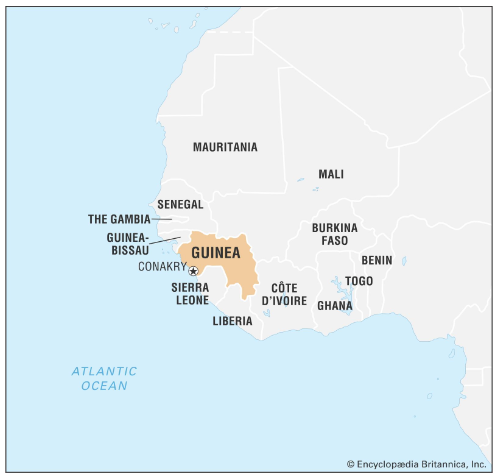
Mudichu Thalapalli, Telangana
A 3000-year-old Iron Age Geoglyph circle was discovered in Telangana
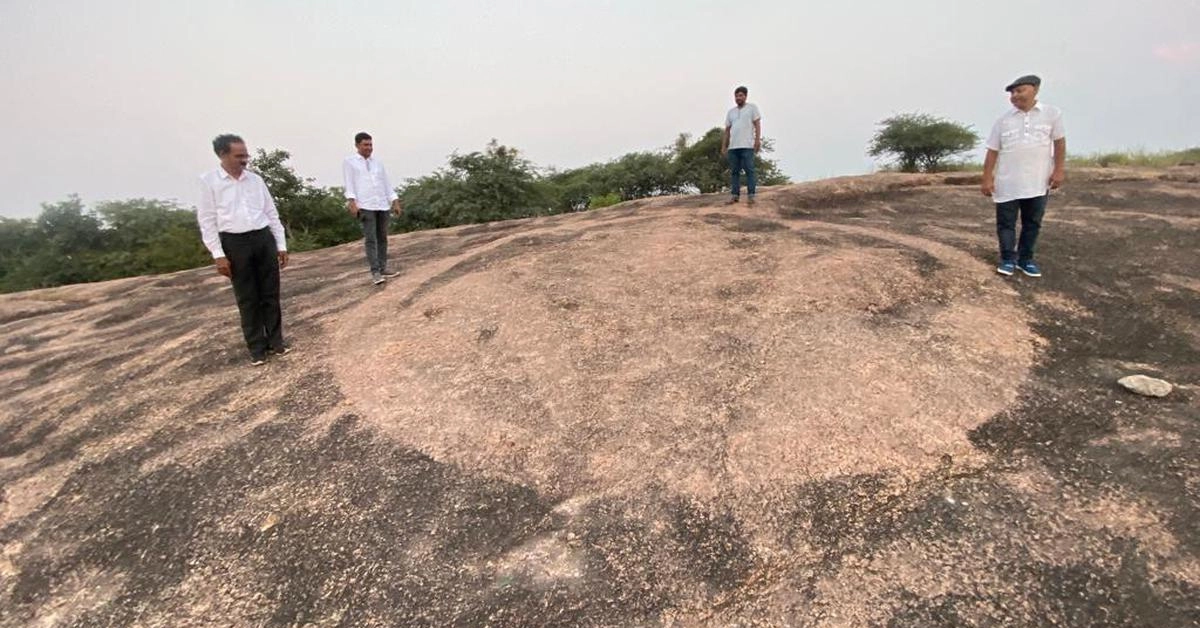
Loktak Lake, Manipur
In News: Manipur Government raised concern that Loktak lake hydroelectric plan may affect Sangai deer.
Things to Remember: Loktak Lake and Sangai Deer
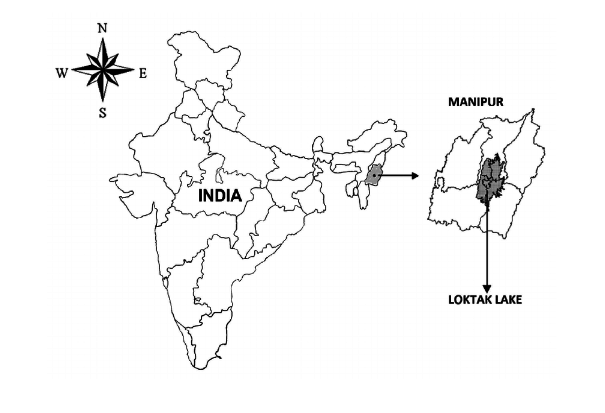
Loktak Lake
- It is a freshwater lake in the state of Manipur.
- It is famous for unique floating islands called Phumdis with multiple plant species.
- The Keibul Lamjao National Park, located on the Loktak Lake is the last natural habitat of the “Sangai” the dancing deer of Manipur.
- It is regarded as among the most beautiful and ecologically diverse lakes in the Northeast.
- The lake is designated as a wetland of international importance under the Ramsar Convention.
About Sangai:
- It is subspecies of Eld's deer that is endemic to Manipur.
- It also has immense cultural relevance to Manipur.
- Distribution: It is found only in Keibul Lamjao National Park; the largest single mass of phumdi is in Loktak Lake – in Manipur’s Bishnupur district.
- The deer walks on the hind surface of its pasterns with mincing hops over floating foliage and is hence also called the Dancing Deer.
Gwalior, Madhya Pradesh
Gwalior joined the UNESCO Creative Cities Network
In a significant recognition of their contributions to literature and music Gwalior in Madhya Pradesh has been added to UNESCO’s prestigious list of Creative Cities.

Gwalior: City of Music
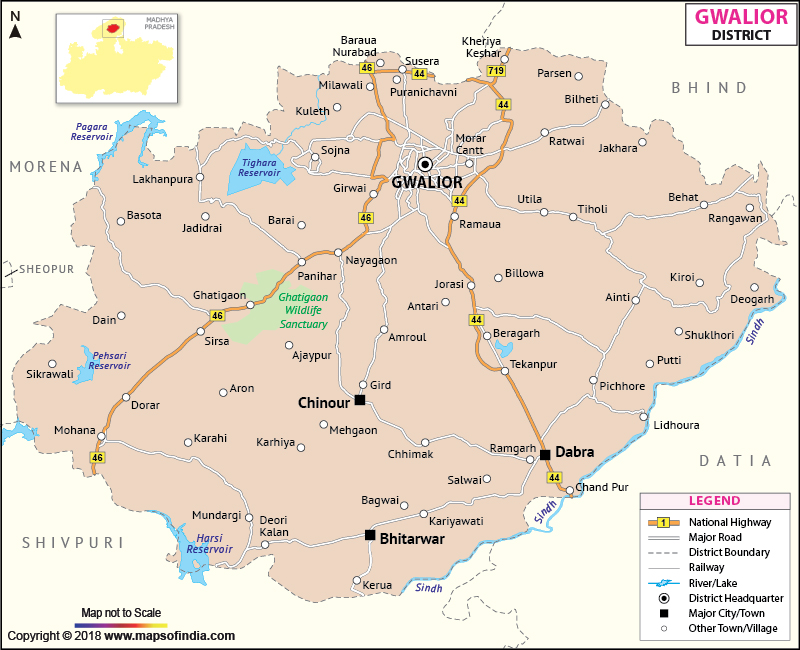
Gwalior boasts a rich and diverse musical heritage, encompassing classical Hindustani music, folk music, and devotional music.
Things to Remember- Gwalior Fort
Gwalior Fort
- The Fort contains several temples and structures.
- The oldest temple is Teli ka Mandir (8th century). This temple has a Valabhi shikhara on a Nagara base.
- Another important temple is the Chaturbhuj Temple built in 875 AD. It is the only monolithic rock cut temple in the whole region.
- The Sas Bahu Temple or Sahastrabahu Temple was built by King Mahipala of the Kachchhapaghata dynasty in 1092. It is a beautiful structure embellished with ornate carvings.
- The temples and the Fort are built with limestone and sandstone.
- The Fort contains many Jain temples as well. The Siddhachal Jain Temple Caves house a 58-feet tall statue of the first Tirthankara, Adinatha or Rishabhanatha.
- There are several other palaces, structures and idols within the Fort. The palace of Raja Maan Singh is a great example of Hindu architecture assimilated with aspects of Islamic architecture.
- Other important structures are Ganesha Gate, Alamgiri Gate, Badal Mahal, Urwai Gate, Gujari Mahal Museum, Karn Mahal, etc.
- A stamp was issued on 3 August 1984 by India Post in honour of the Fort.
Kadalundi river, Kozhikode Kerala
Shrinking mudflat ecosystem of Kadalundi River is impacting Kadalundi Vallikunnu Community Reserve.
In a significant recognition of their contributions to literature and music, Kozhikode in Kerala has been added to UNESCO’s prestigious list of Creative Cities. UNESCO announced this on October 31, which coincides with World Cities Day.

Kozhikode: City of Literature
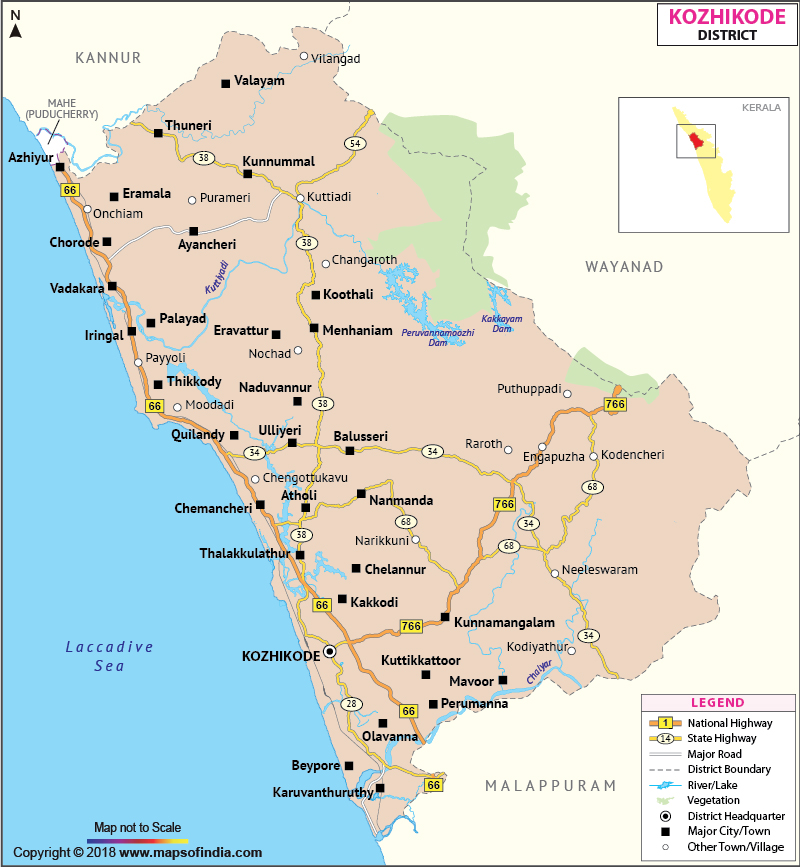
Dhordo – Gujarat
In News: Declared Ghol species as the state fish at the global fisheries confrence India 2023.
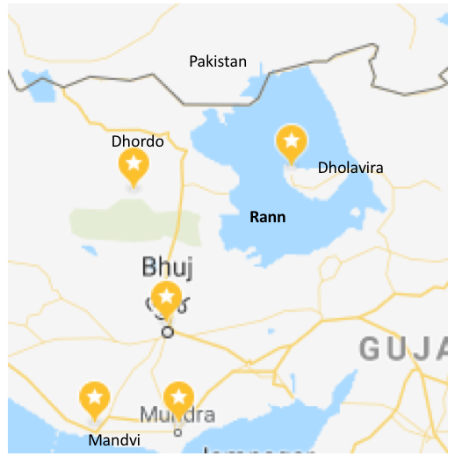
Things to Remember- IVC Sites in Gujarat
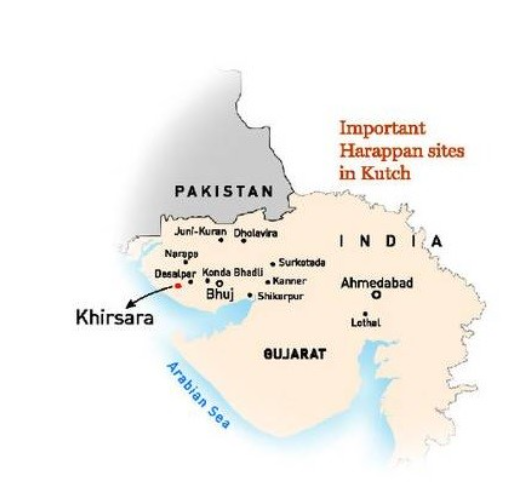
Sambhar Lake – Rajasthan
A researcher unveiled the capability of picocystis Salinarum (green alage) found in hypersaline soda lake Sambhar to survive extreme environments.
About Sambhar Lake
- It is India's largest saline wetland located in Rajasthan.
- It is a ephemeral salt lake,
- It is also a designated Ramsar Site (recognized wetland of international importance).
- It represents the depression of the Aravalli Range.
- This inland lake receives water from five rivers, namely Samaod, Khari, Mantha, Khandela, Medtha, and Roopangarh.
About Picocystis Salinarum:
- It is a globally widespread picoplanktonic green algae of saline lakes.
- The unique organism apparently enhances photosynthesis and ATP synthesis along with chaperone proteins as key response to high salinity-alkalinity.
- Enhanced photosynthetic activity: As photosynthesis is suppressed under hyperosmotic conditions in most photosynthetic organisms.
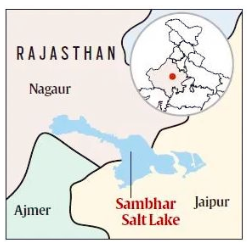
Sutlej River
Researchers found the presence of tantalum in the Sutlej River Sand in Punjab.
About Satluj River
- Satluj, is the longest of the five rivers that flow through the historic crossroads region of Punjab in northern India and Pakistan.
- The Sutlej River is also known as Satadree. Sutlej is an antecedent river.
- An antecedent stream is a stream that maintains its original course and pattern despite the changes in underlying rock topography.
- It is the easternmost tributary of the Indus River.
- The source of the Sutlej is west of the catchment area of Lake Rakshastal in Tibet.
- The nascent river flows at first west-northwest for about 260 kilometres under the Tibetan name Langqên Zangbo (Elephant River or Elephant Spring) to the Shipki La pass, entering India in Himachal Pradesh state.
- It then has its main knee heading west-southwest for about 360 kilometres (220 mi) to meet the Beas River near Harike, Punjab. Ropar Wetland in Punjab state is located on the Sutlej river basin.
- Evidence suggests Indus Valley Civilisation also flourished here.
- Ungti Chu and Pare Chu rivers which drain southeastern part of Jammu and Kashmir state are tributaries of Sutlej river
- The Bhakra Dam is built around the river Sutlej to provide irrigation and other facilities to the states of Punjab, Rajasthan and Haryana.
- The waters of the Sutlej are allocated to India under the Indus Waters Treaty between India and Pakistan, and are mostly diverted to irrigation canals in India to include Sirhind canal, Bhakra Main Line and Rajasthan canal.
- It has several major hydroelectric points, including the 1,325 MW Bhakra Dam, the 1,000 MW Karcham Wangtoo Hydroelectric Plant, and the 1,500 MW Nathpa Jhakri Dam.
- The drainage basin is mainly in India's Himachal Pradesh, Punjab, Jammu and Kashmir and Haryana states.
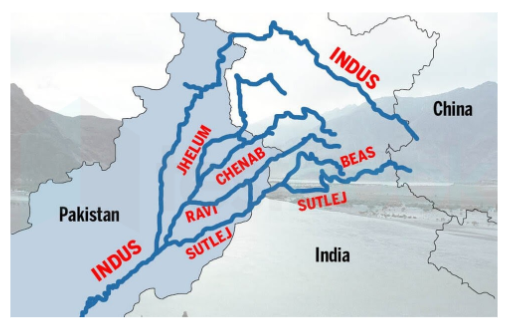
Satluj and pollution
- One of the reasons for the pollution is Buddha nallah, a tributary of the Sutlej.
Properties of Tantalum
- Atomic Number and Characteristics: Tantalum, with the atomic number 73, is a grey, heavy, and highly corrosion-resistant metal. It is known for its hardness and ductility, allowing it to be stretched into thin wires without breaking.
- Corrosion Resistance: Tantalum’s corrosion resistance is attributed to the formation of a highly resistant oxide layer when exposed to air.
- Chemical Immunity: It is almost completely immune to chemical attack at temperatures below 150°C and is attacked only by specific corrosive substances, such as hydrofluoric acid and certain acidic solutions.
Uses of Tantalum
- Electronics: Tantalum capacitors are crucial in electronic devices, storing more electricity in smaller sizes without leakage.
- Substitute for Platinum: Tantalum’s high melting point makes it a cost-effective substitute for platinum in various applications.
- Industrial Applications: Used in chemical plants, nuclear power plants, aircraft, missiles, and surgical equipment.
- Cutting-Edge Material: Composite materials like tantalum carbide (TaC) and graphite, known for extreme hardness, are used in high-speed machine tool cutting edges.
Japan Gets New Island After Volcanic Eruption
- Japan, known for its stunning landscapes and geological activity, has recently witnessed the birth of another island in its archipelago. This phenomenon occurred due to a series of volcanic eruptions near Iwoto Island in the Ogasawara island chain, showcasing the dynamic nature of the country’s geography.
- Phreatomagmatic eruptions, which occur when magma interacts with water, created a landmass approximately 100 meters in diameter.
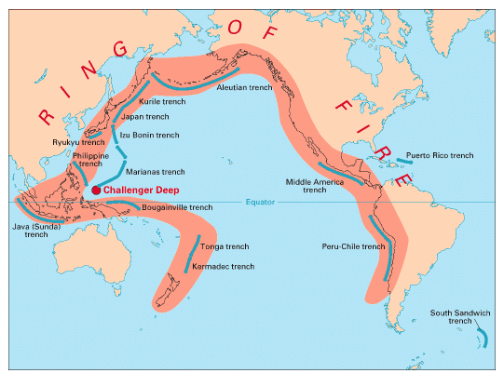
Bering Sea
In News: A recently study revealed a link between declining Bering Sea Ice and increasing wildfire hazard in northeast China.
Things to Remember:
- It is bordered by the US state of Alaska to the east and northeast, the Kamchatka Peninsula and the Far Eastern region of Russia in the west, and the chain of the Aleutian Islands in the south.
- The boundary between the United States and Russia passes through the sea and the strait.
Canyons:
- There are about 16 submarine canyons in the Bering Sea.
- Situated in the sea’s center is a large underwater canyon known as the Zhemchug Canyon. It is also the world’s largest and deepest submarine canyon.
- Rivers: The two rivers that drain into the sea are the Anadyr and the Yukon Rivers.
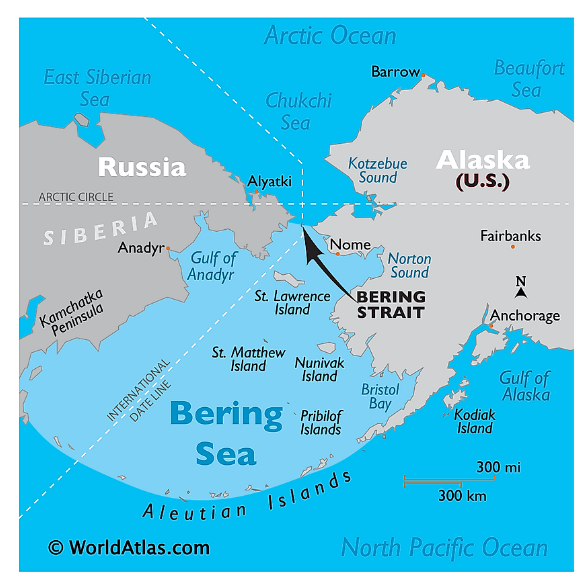

Senegal
In News: Senegal host first meeting of WHO’s initiative Global Onchocerciasis Network for Elimination (GONE)
Things to Remember
- Country Boundary Senegal – Mauritania, Mali, Gambia, Guinea Bissau, Guinea
- River – Senegal River
GONE
- GONE was launched in 2023 to accelerate progress towards onchocerciasis (river blindness) targets set in the 2030 Neglected Tropical Disease (NTD) roadmap.
- It provides a platform for endemic countries, civil society organizations, and individuals to share experiences and challenges, identify gaps and best practices.
Onchocerciasis
- Onchocerciasis is an eye and skin disease, commonly known as “river blindness”.
- It is caused by the parasitic worm Onchocerca volvulus.
- Transmission by: Repeated bites of infected blackflies (Simulium spp.).
- These blackflies breed along fast-flowing rivers and streams, close to remote villages located near fertile agricultural lands.
- Symptoms: Severe itching, disfiguring skin conditions, and visual impairment, including permanent blindness.
- Prevalence: More than 99% of infected people live in 31 countries in sub-Saharan Africa (Tropical areas), in 2 countries in Latin America and Yemen.
- At least 220 million people required preventive chemotherapy against Onchocerciasis.
- 14.6 million of the infected people already had skin disease and 1.15 million had vision loss. (Global Burden of Disease Study, 2017)
- Treatment: Mass Drug Administration with Ivermectin.
- Colombia, Ecuador, Mexico, and Guatemala have been verified by WHO as free of onchocerciasis.

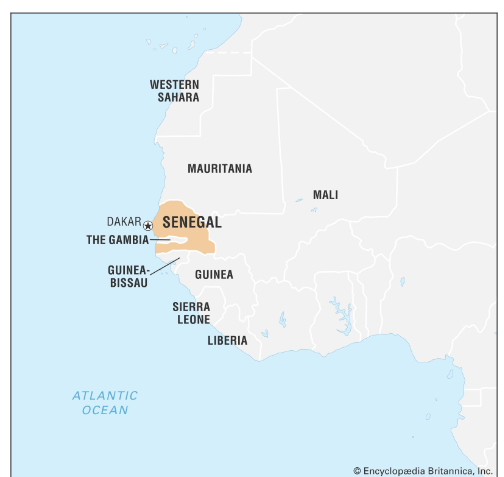
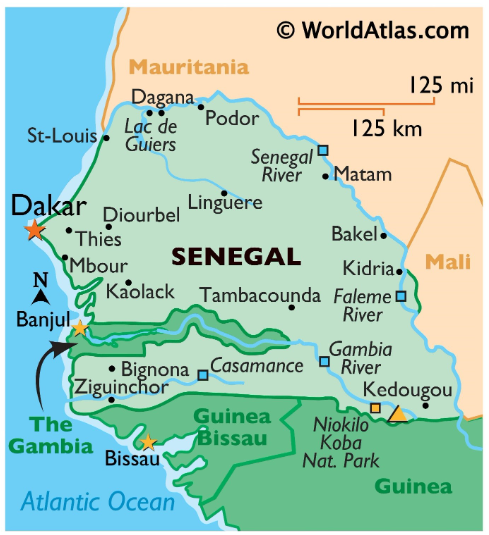
Australia
In News: Australian Government announced to issue a national apology to all citizens affected by the Thalidomide tragedy
Things to Remember:
Australia Economy, Trade with India, Import Export of Highest Product, Trade agreement etc.
Thalidomide tragedy
- Thalidomide is a sedative and anti-nausea over-the-counter drug, that was prescribed to pregnant women in the late 1950s and early 1960s, to alleviate morning sickness, cure anxiety, insomnia, gastritis, and tension.
- Over-the-counter drugs are drugs that can be taken without the formal prescription of the physician.
- It was not tested on pregnant women.
- It was first developed in Germany in 1957 and later introduced in several other countries.

Dominica
In News: Dominica has announced to create world’s first sperm whale reserve.
Things to Remember: Arrange Island from East to West or North to South
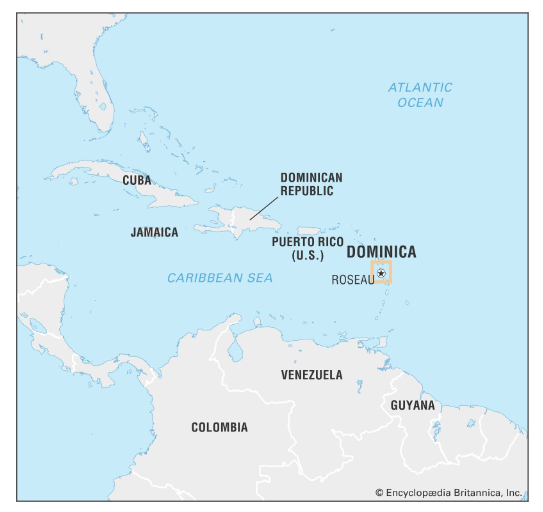
Qatar
In News: A court in Qatar sentenced eight former personnels of the India Navy to death.
Things to Remember:
- Boundary Share with: Qatar has one land border. The country borders Saudi Arabia to the south. The boundary with Saudi Arabia was settled in 1965 but never demarcated.
- Qatar member of GCC - Gulf Cooperation Council countries – Bahrain, Kuwait, Oman, Qatar, Saudi Arabia and the United Arab Emirates.
- Doha Political Declaration’: The 5th United Nations Conference on the Least Developed Countries (LDC5) concluded with adoption of the ‘Doha Political Declaration’ by the world leaders.
- Doha Amendment: The Doha Amendment establishes a second commitment period (2013–20) for the Kyoto Protocol, an international agreement to reduce the emissions of greenhouse gases.
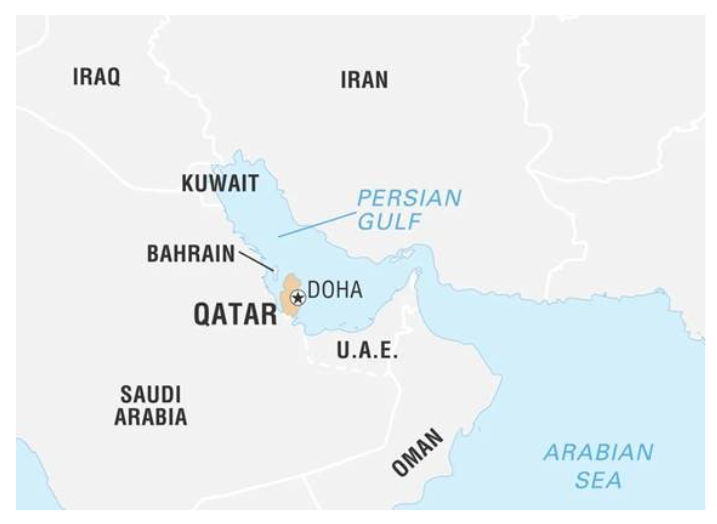
Italy
In News: Mount Etna Volcano began erupting again on Island of Sicily.
Things to Remember:
Volcano in Italy: Mount Etna is one of the most active volcanoes in the world and is in an almost constant state of activity
- Etna
- Stromboli
- Vulcano
- Panarea
- Campi Flegrel
- Mar di Sicilia
Country Boundary Adriatic Sea: Italy, Croatia, Bosnia and Herzegovina, Montenegro, Albania and Slovenia.
Country Boundary Italy: To the north the Alps separate Italy from France, Switzerland, Austria, and Slovenia. Elsewhere Italy is surrounded by the Mediterranean Sea, in particular by the Adriatic Sea to the northeast, the Ionian Sea to the southeast, the Tyrrhenian Sea to the southwest, and the Ligurian Sea to the northwest.

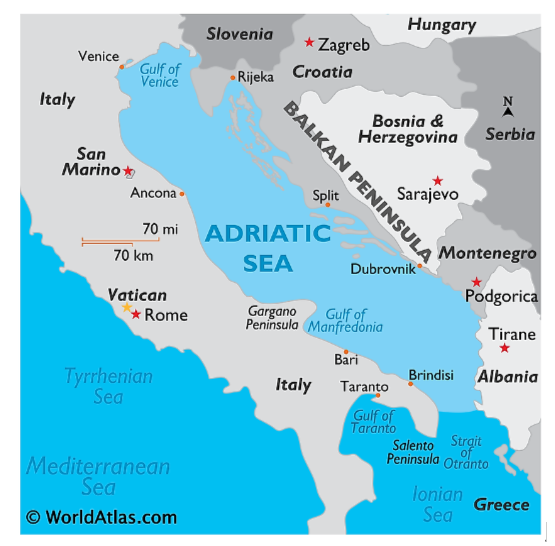
Switzerland
In News: 5th meeting of Confrence of Parties (COP 5) to Minimata Convention held in Geneva.
Things to Remember
- Geneva in Switzerland
- Country share boundary with Switzerland – Germany, Austria, Italy, France
- Minamata Convention - The Minamata Convention on Mercury is a global treaty to protect human health and the environment from the adverse effects of mercury and its compounds.
About Mercury
- Mercury is a naturally occurring element found in the Earth's crust. It is considered by the World Health Organization (WHO) as one of the top ten chemicals or groups of chemicals of major public health concern.
Major Applications of Mercury:
- Thermometers and Barometers: Mercury's high coefficient of thermal expansion and easy visibility make it suitable for use in traditional thermometers and barometers.
- Chemical and Mining Processes: Mercury has been used in various chemical and mining processes, including the production of chlorine and mining of gold.
- Electronics and Electrical Switches: Mercury-wetted switches are used in various electrical applications because mercury's conductivity and low resistance make it suitable for creating a reliable electrical connection.
Methylmercury and ethylmercury: These differ significantly. While methylmercury is linked to health issues, ethylmercury is utilized as a preservative in certain vaccines and is not associated with health concerns.
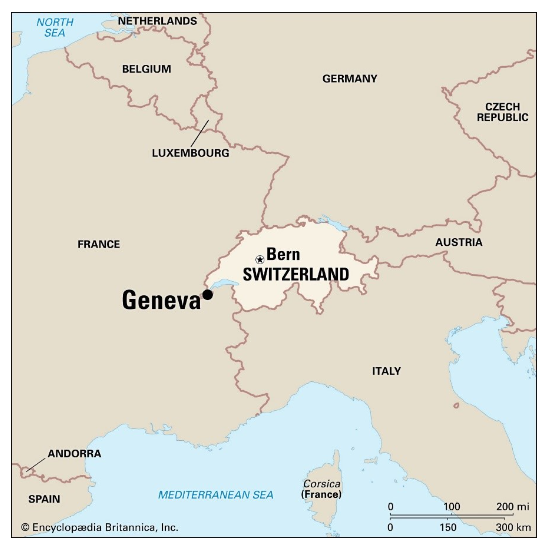
Iceland - Edukemy Current Affairs
In News: A state of emergency was declared in Iceland after powerful earthquakes rocked the Reykjanes peninsula, signaling a possible volcanic eruption could occur within days.
Things to Remember
- Reykjanes peninsula
- Fagradalsfjall

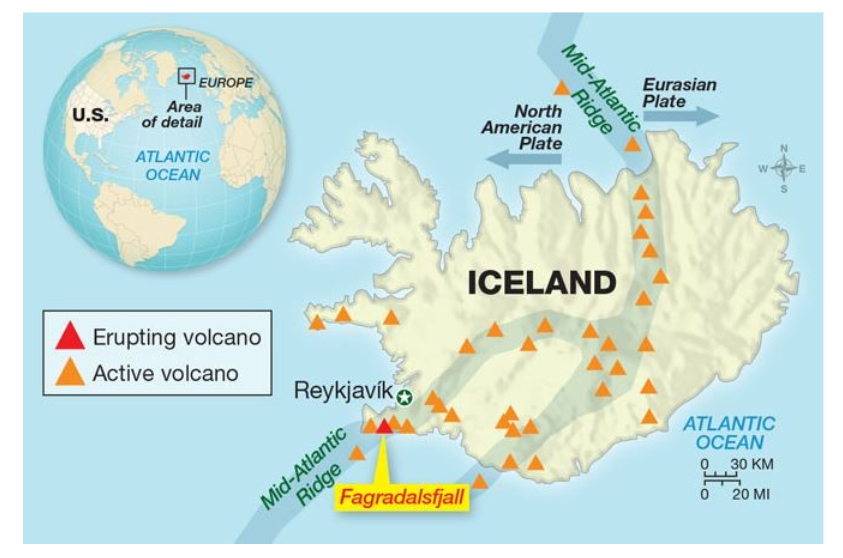
Share the article
Get Latest Updates on Offers, Event dates, and free Mentorship sessions.

Get in touch with our Expert Academic Counsellors 👋
FAQs
UPSC Monthly Current Affairs refers to a compilation of relevant and significant news, events, and developments from various fields that are important for the UPSC (Union Public Service Commission) civil services examination. This curated collection helps aspirants stay updated with recent happenings, enhancing their knowledge and analytical skills, which are crucial for various stages of the UPSC exam, including the Preliminary, Main, and Interview rounds.
UPSC Monthly Current Affairs plays a crucial role in UPSC preparation as it helps aspirants cover a broader range of current affairs topics within a specific time frame. By reviewing monthly current affairs, aspirants can gain a deeper understanding of significant events and issues, analyze their implications, and connect them with the UPSC syllabus. It aids in building a holistic perspective and enhances the ability to answer questions effectively.
UPSC Monthly Current Affairs provides a comprehensive overview of important events and developments across various domains. It covers national and international news, government policies, economic updates, scientific advancements, environmental issues, social issues, sports events, cultural festivals, and more. The content typically includes summaries, analysis, infographics, and practice questions to facilitate effective learning and revision.
You can access UPSC Monthly Current Affairs through various sources and platforms:
- Online Education Websites: Websites like Edukemy, Unacademy, BYJU'S, and others often provide monthly current affairs compilations tailored specifically for UPSC aspirants.
- Newspapers and Magazines: Reputed newspapers like The Hindu, The Indian Express, and magazines like Yojana and Kurukshetra provide comprehensive coverage of current affairs. Many coaching institutes also compile and publish monthly magazines focusing on UPSC-related current affairs.
- Mobile Apps: There are dedicated mobile apps that are available on platforms like Google Play Store and Apple App Store that provide UPSC-focused current affairs content. Edukemy's app is the best in the industry for current affairs preparation.
- YouTube Channels and Podcasts: Many educators and institutes have YouTube channels and podcasts that discuss and analyze current affairs topics relevant to the UPSC exam. Visit Edukemy's YouTube channel and get covered with all the current affairs required for UPSC preparation.
- Coaching Institutes: Many offline and online coaching institutes like Edukemy offer UPSC Monthly Current Affairs as part of their study materials or subscription plans.
When accessing UPSC Monthly Current Affairs, ensure that the content is reliable, well-researched, and covers a wide range of topics relevant to the UPSC syllabus. It's essential to stay updated with national and international developments, government policies, socio-economic issues, and more to excel in the UPSC exam.



